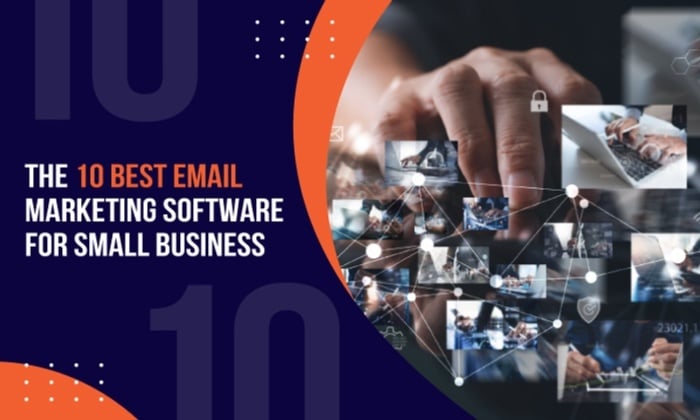2024 SEO Blueprint: Your Comprehensive 5-Guide Stack To SEO Strategy via @sejournal, @Conductor
So, how do you know what to track and how to track it – especially when this often varies by industry, too? The post 2024 SEO Blueprint: Your Comprehensive 5-Guide Stack To SEO Strategy appeared first on Search Engine...



NOTE FROM EDITOR
Isn’t it funny how easy it is to forget the tidbits of the tried-and-true elements that are so essential to our work?
I’m reminded of one today: Not all metrics are created equal.
Sometimes, it feels like there are so many to keep track of. KPIs, benchmarks, analytics – oh, my! And even if their cores are quite different in what they measure and indicate, they’re all vital in the world of SEO.
So, how do you know what to track and how to track it – especially when this often varies by industry, too?
That question is what makes this collection of articles so fascinating to me, especially the piece below, “KPIs, Metrics & Benchmarks That Matter For SEO Success.” You mean, it’s possible to narrow them down? (Narrator: It is.)
We all know that monitoring competition, building trust with users, and focusing on the most informative and helpful content possible is important, but depending on your industry, are there some that you should prioritize above others?
The answer might surprise you.
Until next time – read on, my friends.

Amanda Zantal-Wiener Editor-In-Chief, Search Engine Journal
10 Strategic SEO Insights & Tactical Advice For 2023 And Beyond
Despite the current changes in the digital marketing landscape, SEO remains essential.
 Greg Jarboe
17K Reads
Greg Jarboe
17K Reads

I’ve written about search engine optimization (SEO) for over 20 years.
So, I wasn’t shocked when the editors asked me to refresh an article I wrote on October 21, 2020, titled “3 Strategic SEO Insights & Tactical Advice for 2021.”
But looking back at what I’d written two-and-a-half years ago, I realized that my actionable insights now need to be thoroughly updated in this era of constant change.
The advent of OpenAI’s ChatGPT on Nov. 30, 2022, has triggered a “code red” at Google, which rushed out a new experimental conversational AI service called Bard in response to Microsoft’s AI-enhanced Bing.
UBS estimates that ChatGPT reached 100 million monthly active users in January, 2 months after its launch. According to the Swiss bank’s analysts, it would be the fastest-growing online application in history.
So, what strategic SEO insights and tactical advice could I share with you today that will still be relevant a year from now?
What critical data or search trends would encourage you to display a motivational poster on your wall that advises everyone to “Keep Calm and Carry On”?
By the way, that last piece of advice is not half bad.
Google was launched on Sept. 4, 1998, and didn’t pass AltaVista to become the leading search engine until the second half of 2002 – about 4 years later.
And even the Panda Update, which shocked the SEO industry and effectively ended the “content farm” business model, only impacted 12% of queries, according to the History of Google Algorithm Updates.
The Penguin Update, which downranked websites that engaged in aggressive webspam, only impacted 3.1% of English queries.
And it’s worth recalling that the first iteration of the Panda Update started on Feb. 23, 2011, but was followed by 27 more adjustments until the final update on July 17, 2015. And the Penguin Update, which began on April 24, 2012, didn’t end until Sept. 23, 2016.
It may take more than four years to know the full impact of Google’s Bard AI or the new AI-powered Bing search engine.
So, SEO professionals would be well advised to “Keep Calm and Carry On.”
That means I can confidently share 10 strategic insights, bits of critical data, pieces of tactical advice, or search trends that will impact SEO in 2023 and beyond without losing too much sleep over the fact that 30% of them may not be relevant a year from now.
(After telling you why “the fundamental things apply as time goes by,” I’ll circle back to explain why a 70% success rate is the right benchmark.)
SEO remains an essential element of any digital marketing strategy.
And even though the search industry is constantly changing, Google is still the leading search engine.
According to Similarweb, Google.com got 3.2 billion unique visitors in January 2023, making it the most visited website globally. The search giant also got 88.3 billion visits in January 2023.
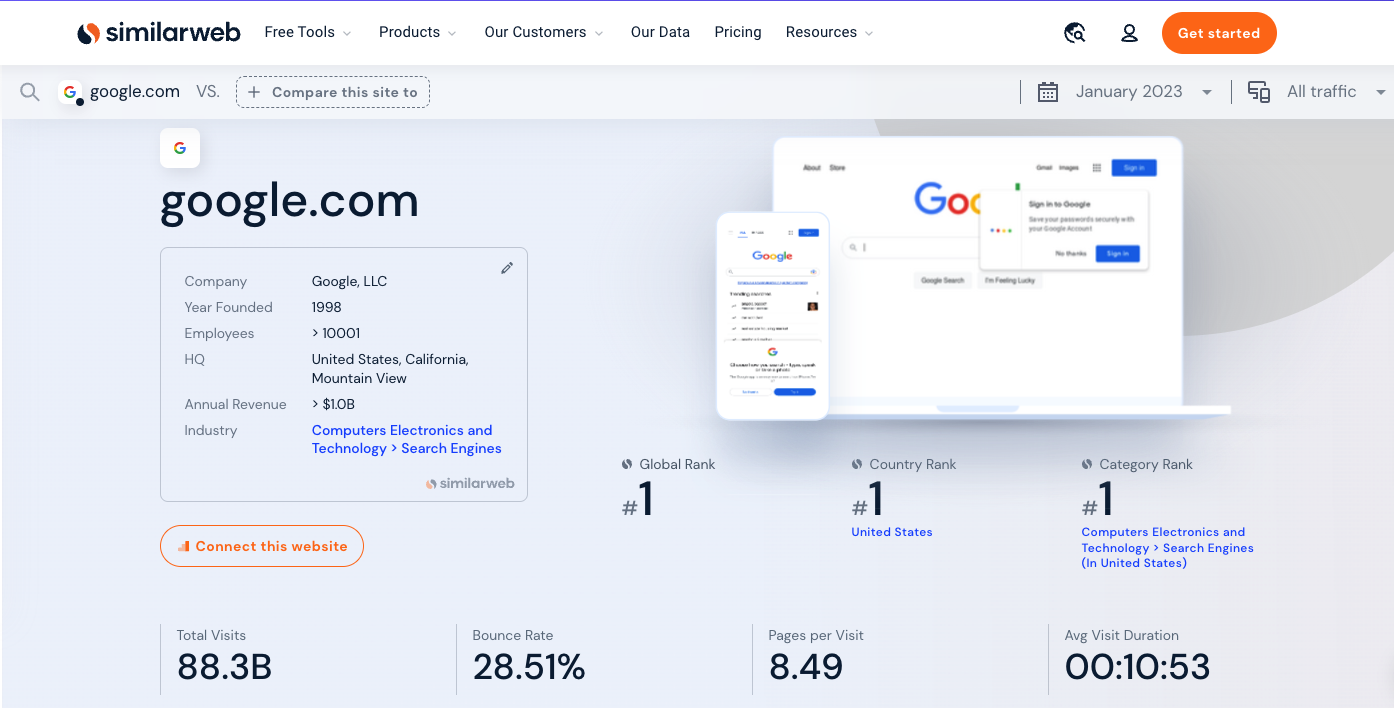 Screenshot from Similarweb, February 2023
Screenshot from Similarweb, February 2023
So, don’t bet the farm on Google going away anytime soon.
And if you need to keep other people within your company, or at one of your clients, from rushing off to panic stations, then show them the chart below from Google Trends, which displays worldwide web search interest over the past 90 days for the search terms Google, ChatGPT, and Bing.
You can calmly explain that the dips in interest for Google occur on weekends.
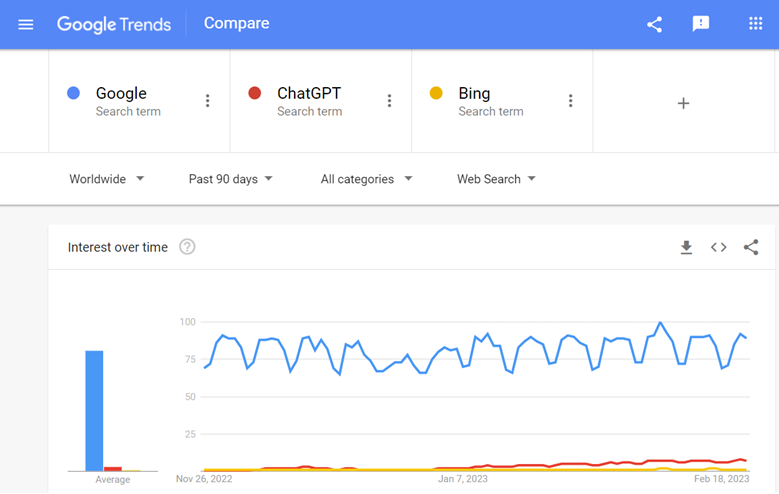 Screenshot from Google Trends, February 2023
Screenshot from Google Trends, February 2023
If Google remains the dominant search engine for the foreseeable future, then SEO pros don’t need to be retrained or replaced.
Why? Because they’re already familiar with Google Search Essentials (formerly Webmaster Guidelines).
And they’ve successfully navigated through the 22 Google Search ranking updates.
This is why I’m confident that more than 70% of SEO pros will continue successfully navigating the uncharted areas of keyword maps that bear the phrase: “Here be dragons.”
1. Focus On User Intent
One of the most important aspects of SEO is understanding user intent.
Google’s algorithms have become more sophisticated, and they’re now better able to understand the intent behind a query.
So, SEO pros should focus on creating content that satisfies user intent rather than just targeting specific keywords. This means creating content that is not only relevant to the user’s search query, but also provides helpful information or a satisfying experience.
Now, I realize this strategic insight isn’t breaking news.
But you still might benefit from re-reading my article, The Future of SEO Lies in the ‘Messy Middle’ of the Purchase Journey.
According to research by Google’s Market Insights team in the U.K., the “messy middle” is where people decide what to buy.
Among other things, this research found:
“People look for information about a category’s products and brands, and then weigh all the options. This equates to two different mental modes in the messy middle: exploration, an expansive activity, and evaluation, a reductive activity. Whatever a person is doing, across a huge array of online sources, such as search engines, social media, aggregators, and review websites, can be classified into one of these two mental modes.”
Let me translate this “big idea” into counter-intuitive tactical advice: SEO pros must create and optimize at least two pieces of content to address the user’s different intents in the “messy middle” of the purchase journey.
And, if your company or client is targeting half a dozen different segments, then you need to create and optimize at least a dozen pieces of content.
Creating and optimizing one page for each target segment is so 2019.
2. Create High-Quality Content
Content is still king, but if SEO managers want to become prime ministers (or presidents) someday, then they need to create more original, helpful content written by people, for people.
How can you ensure you’re creating high-quality content? By following Google’s long-standing advice and guidance for core updates to create content for people, not for search engines.
So, let me suggest you re-read my article, What Is A Content Marketing Matrix & Do We Need One?
It shows you how to use a content marketing planning tool to generate ideas for enchanting content that changes hearts, minds, and actions. That’s how you become the VP of SEO.
3. Prioritize E-E-A-T
On Dec. 15, 2022, Google updated its search rater guidelines – adding an extra E for Experience to the concept of E-A-T: Expertise, Authoritativeness, and Trustworthiness.
Although these guidelines don’t directly influence ranking, they are useful for anyone who works in SEO because they give us an idea of where Google wants its algorithms to go.
To improve your content’s E-E-A-T, someone with first-hand life experience on the topic should produce it.
If you can’t convince someone with experience to produce this content in-house, you need to find a freelance writer – or content creator – who has used your product or service, visited a place, or influenced brand purchases.
Unfortunately, many SEO pros still don’t think this is their job – even though the first mention of E-A-T occurred in 2014 when Google added the concept to its Search Quality Guidelines.
Even Google said:
“These are not fundamentally new ideas. And we’re by no means abandoning the fundamental principle that Search seeks to surface reliable information, especially on topics where information quality is critically important.”
If you’d like some practical advice, read How To Find Talented Writers To Fuel Top Quality Content Creation, which includes my interviews with a couple of thought leaders in this field.
4. Optimize YouTube Content
According to the Video & Visual Storytelling Survey by Content Marketing Institute (CMI) published on Oct. 27, 2022, 73% of marketers said videos have become more important to their business in the last year; 27% said they are about the same in importance; and, no one said videos have decreased in importance.
Why should SEO pros lose sleep over this critical data?
Because the content marketing department, not the SEO department, is jumping on this trend.
And that means many of the videos cranked out in 2023 and beyond won’t be optimized for search – let alone integrated into an overall SEO strategy.
So, here’s some tactical advice: first, read Sam Hollingsworth’s guide, YouTube SEO: How To Optimize Videos & Rank Higher.
Next, invite the content marketing department to a brown bag lunch to discuss ways to create great content together.
5. Earn High-Quality Links
Links continue to be one of Google’s most important ranking factors. And at least 70% of SEO pros have already read articles like:
Tom McLoughlin’s The PR Process That Drives Hundreds of Links Time After Time. Jeremy Knauff’s How To Earn Links By Doing Something Truly Newsworthy. Maddy Osman’s How To Get Quality Links With Thought Leadership & Speaking. My article, Google News Optimization: How To Boost Your Site’s Visibility & Traffic. My guide, 7 Steps To Building A Kickass Digital PR Campaign.Unfortunately, the lion’s share of chief communications officers (CCOs) and public relations officers (PROs) haven’t read articles like these.
So, only a handful of organizations use one of the most effective techniques to earn links to help your website rank higher on search engines.
Ironically, the biggest barrier is not journalists. Pogo once observed, “We have met the enemy and (they are) us.”
This means you might need to invite your CCO or PRO to a swanky restaurant to discuss link building instead of hosting another brown bag lunch.
But this is a better use of your time and money than trying to figure out a clever way around Google’s December 2022 link spam update, which can now detect both sites buying links and those used to pass outgoing links.
6. Optimize For Local Search
Brick-and-mortar businesses serving specific towns, cities, regions, and states know local search is important.
When done correctly, local SEO enables people to find information about their business, putting them one step closer to making the cash register ring.
And SEO pros specializing in local search know a consistent Name, Address, and Phone number (NAP), local links, local reviews, and star ratings, as well as optimized Google Business Profiles, are important parts of Google’s local search and Local Pack algorithms.
But, to learn the latest trends and tips to help your local business grow using local search optimization, local marketing, and local advertising, read Search Engine Journal’s A Guide to Local SEO, which tackles what you need to know about optimizing for local search.
7. Keep An Eye On Multisearch
In April 2022, Google introduced an entirely new way to search using text and images simultaneously.
With multisearch in Lens, users can go beyond the search box and ask questions about an object or refine their search by color, brand, or visual attribute.
To learn more about this, read Matt G. Southern’s article, Google Multisearch: A New Way To Search With Text & Images.
Then, read Roger Montti’s article, How Does Google Multisearch Affect SEO?
So, keep an eye on multisearch in 2023 and beyond.
8. Keep Your Ear To The Ground For Voice Search
According to Roger Montti’s article, Google: Voice Search Is Not The Future, Google’s Martin Splitt shared his opinion that voice search is not the future and that there will be no need to optimize for it.
Even though I’ve written about Amazon’s Big Game Commercial: Mind Reader twice in the past year, I haven’t paid much attention to voice search until I was prompted to read a couple of recent articles on this topic, including:
Ludwig Makhyan’s Voice Search Optimization At Scale: A Guide For Enterprise Marketers. He wrote, “We’ve seen a cosmic shift to voice search.” Brian Frederick’s Tips For Leveraging The Power Of Voice Search Optimization. He wrote, “According to Statista, there will be 8 billion voice assistants in use worldwide by 2024.” Chelsea Alves’ Voice Search: What Is It & How Does It Work? She wrote, “If your business isn’t focusing on voice search optimization, you could be missing out on sales.”And while writing this article, I re-read Kristopher Jones’ How Can Voice Search Benefit Your SEO? He wrote:
40.2% of Americans use voice search. 71% of people prefer using voice search to physically typing out a search online. 27% of the online population worldwide uses voice search on mobile. 58% of people have used voice search to find information about local businesses.In other words, four out of five people with a veritable ton of E-E-A-T think that voice search represents a phenomenal SEO opportunity.
So, keep your ear to the ground for new voice search developments in 2023 and beyond.
9. Migrate To Google Analytics 4 (GA4)
I’ll bet Google sent you an email with the subject line: “We’ll soon configure Google Analytics 4 for you.”
It said:
“For any customer who does not set up a GA4 property with basic settings, starting in March, we will configure one with a few basic settings consistent with the existing Universal Analytics property; this includes certain conversion events, Google Ads links, and existing website tags.”
This means the chaos expected on July 1, 2023, when standard Universal Analytics properties will stop working, has arrived ahead of schedule.
And, as Sun Tzu once observed, “In the midst of chaos, there is also opportunity.”
In my article, Google Analytics 4 Should Trigger Reorganizations & Agency Reviews, I said the advent of GA4 would cause the marketing department to start “freaking out” if the web analytics team – which still sits in the IT department in far too many organizations – doesn’t respond to urgent requests for “help” within a week, a day, or even an hour.
So, this is the perfect time for you to make the business case for moving the analytics team out of the IT department and into the SEO department.
If there’s any pushback, remind decision-makers that 53.3% of all website traffic comes from organic search, according to BrightEdge Research.
10. Build A War Room
If you’re a chief marketing officer (CMO) or vice president of Marketing and you move the analytics team into the SEO department, your team may ask to build a dashboard. Build a war room instead.
Why? Because “most dashboards tend to stink when it comes to helping the Executive make any decisions,” according to Avinash Kaushik, the Digital Marketing Evangelist for Google.
This is because the interpretation of the “easy-to-understand visuals” in most dashboards is left to the executive.
But most war rooms feature not only maps of the global market and charts of the company’s key performance indicators (KPIs), but also an analytics and insights manager with the experience, expertise, authoritativeness, and trustworthiness to interpret the trends and add context.
This “Analysis Ninja” can explain to executives why some key trends are up or down (in plain English).
And over time, executives will begin to ask their analytics and insights manager to recommend which actions or steps should be taken to move the dial.
And an Analysis Ninja can answer the question, “As a result of this trend (up or down) what was the impact on the company and its customers?”
Why Should SEO Pros Adopt The 70% Solution?
Now that I’ve shared 10 strategic SEO insights and some counter-intuitive tactical advice for 2023 and beyond, I’ll circle back to explain why a 70% success rate is the right benchmark.
Ty Kiisel’s article, 70% Solution: The Marine Corps Framework for Making Battlefield Decisions, should be required reading for every SEO manager who wants to become the VP of SEO someday.
The Marines teach their young officers what they call the 70% solution.
And it could be a good strategy to adopt for making decisions in situations where you don’t have all the information or resources you’d like.
In a perfect world, you’d have all the critical data you need to make informed decisions. But we don’t live in a perfect world.
Nevertheless, if you have 70% of the information you’d like to have, then you can still make good decisions – provided you accept the notion that you may need to adjust and compensate for the critical data you lack as you move forward.
And like battlefield commanders, most SEO managers never have all the resources they need to meet their objectives.
But it can sometimes be enough if you have good people and 70% of what you need. And finding creative solutions to challenges is a hallmark of successful SEO professionals.
Finally, are you 70% confident that your plan will succeed?
In other words, do you feel good about your plan’s success with the information and resources you have?
The Marines believe a well-conceived plan, along with taking the initiative, is more likely to succeed than doing nothing.
This is why I can confidently share 10 strategic insights, bits of critical data, pieces of tactical advice, or search trends that will impact SEO in 2023 and beyond without losing too much sleep over the fact that 30% of them may not be relevant a year from now.
The Marines have given us a framework for making decisions in less-than-ideal circumstances.
That is why you should “Keep Calm and Carry On.”
More Resources:
57 SEO Insights From Google’s John Mueller 7 Essential Insights For SEO Client Reports State Of SEO: Performance, Salaries & BudgetsFeatured Image: Monster Ztudio/Shutterstock
KPIs, Metrics, & Benchmarks That Matter For SEO Success by Industry
This post was sponsored by Conductor. The opinions expressed in this article are the sponsor’s own.
 Conductor
23 Reads
Conductor
23 Reads

Wondering how your website’s KPIs and metrics stack up against the industry’s leaders?
Wish you could instantly know what’s working for your competitors so you can take advantage?
Conductor analyzed over 600 enterprise domains from leading brands to help you see what’s working in SEO in 2023.
They categorized each domain into six industries and then further broke them down by subindustries to identify traffic trends, top content providers, and more at a granular level.
Jump To SEO Benchmarks For:
Finance Healthcare Retail Technology Travel & Hospitality Professional ServicesSo, let’s dive into the key context for evaluating your efforts, identifying accurate KPIs, and implementing the right strategies to drive results.
Why KPIs, Metrics & Benchmarks Matter
Organic traffic is the cornerstone of long-term website success, making monitoring its performance through KPIs, metrics, and benchmarks essential.
However, optimizing websites in 2023 is challenging due to frequent Google algorithm changes and a lack of industry-wide benchmarks.
Therefore, establishing reliable KPIs and metrics is crucial for adapting strategies and sustaining long-term success in organic search.
SEO Benchmarks For Finance
In the finance sector, SEO benchmarks are critical for gauging success.
Key Takeaways
Pay attention to more than just direct competitors. Identify the top indirect competitors for your domain and analyze their sites for content strategy opportunities. For Banking and Insurance, banking portal URLs inflate the overall traffic amount to each domain as users log in to their accounts daily. So, Despite the high volume of direct traffic for both industries, organic search is the most effective way to capture searchers still deciding between banking or insurance solutions. For Real Estate, searchers looking into real estate are most likely separate from a brand; investing in non-branded SEO and the website experience is crucial.Top SERP Performers In The Finance Sector
Top players like Investopedia, NerdWallet, Bankrate, WalletHub, and Forbes dominate their industry by crafting high-quality, evergreen content that ranks for informational searches.
Organic Traffic Benchmarks For Finance
The top-performing businesses within the finance sector often see 28% of their traffic coming from organic search, on average.
Here’s a breakdown by subindustry:
Banking: 23% Insurance: 23% Investments: 25% Real Estate: 41% Mortgages: 29%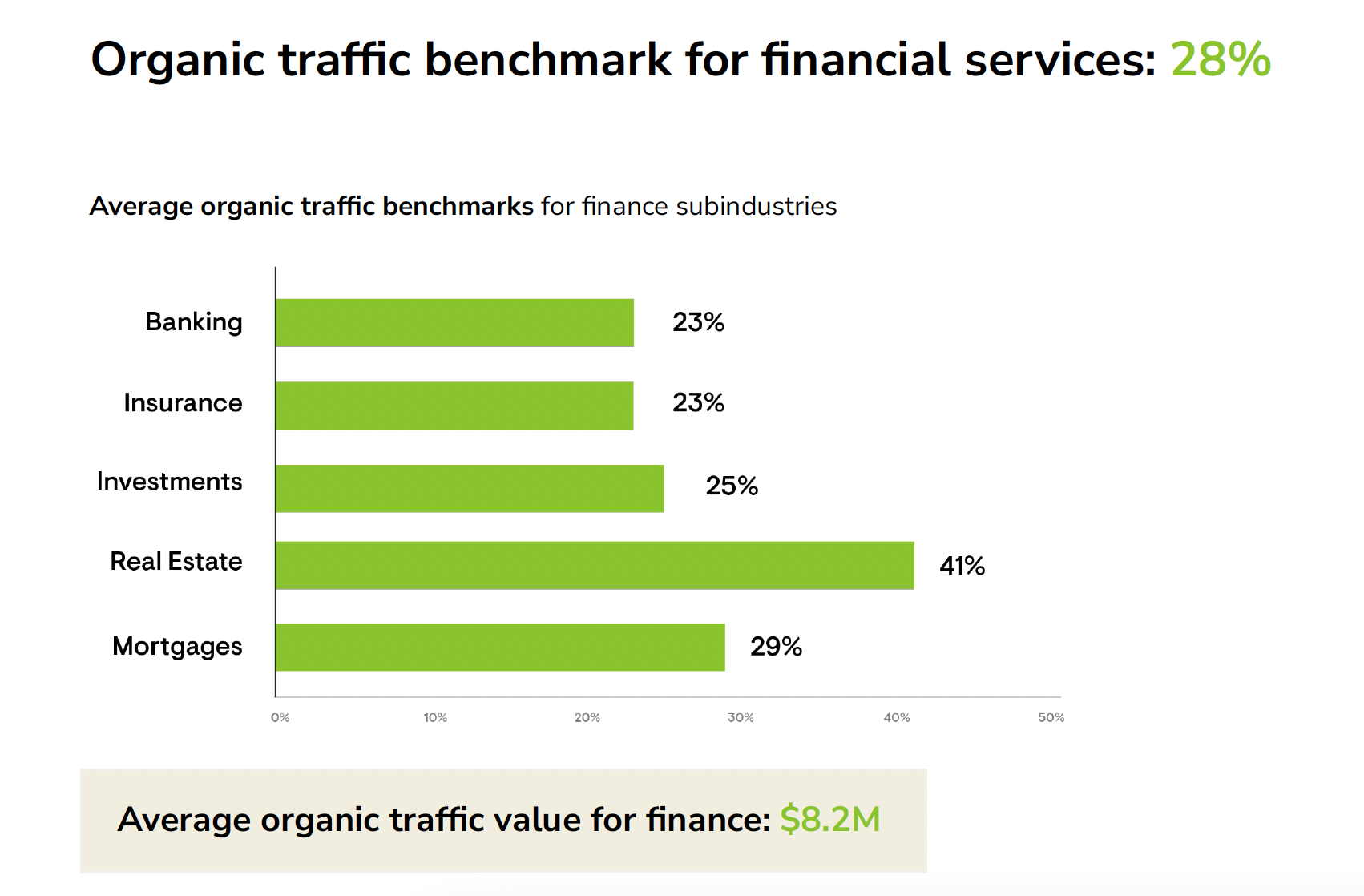 Image created by Conductor, July 2023
Image created by Conductor, July 2023
Branded Vs. Non-Branded Traffic KPIs For Finance
Finances top-performing businesses saw, on average, 71% of their organic traffic came from branded search terms, while 29% came from non-branded traffic.
Here’s the breakdown, buy subindustry:
Banking: 87% branded organic traffic, 13% non-branded organic traffic. Insurance: 70% branded organic traffic, 30% non-branded organic traffic. Investments: 73% branded organic traffic, 27% non-branded organic traffic. Real Estate: 41% branded organic traffic, 59% non-branded organic traffic. Mortgages: 86% branded organic traffic, 14% non-branded organic traffic.Top Finance Content Providers
To understand how your content compares to the Finance companies who rank at the top of SERPs, take a look at each top-ranking company in your subindustry.
The top content providers for the Banking subindustry:
Investopedia Nerdwallet Bankrate WalletHub ForbesThe top content providers for the Insurance subindustry:
Coverfox WalletHub Nerdwallet Investopedia AllstateThe top content providers for the Investments subindustry:
Nerdwallet TheStandard Bankrate SmartAsset InvestopediaThe top content providers for the Mortgage subindustry:
Bankrate Investopedia Consumer Financial Protection Bureau Rocket The Mortage ReportsThe top content providers for the Real Estate subindustry:
Rent Cafe Investopedia MyMove Apartment List RentTop SERP-Rich Result Types For Finance
The top 3 rich search result types for Finance are:
People Also Ask: 81% Featured Snippet: 21% Image: 7%SEO Benchmarks For Healthcare
SEO performance varies among sub-industries like biotech, pharma, and healthcare providers in the healthcare sector. Monitoring these KPIs can help optimize your SEO strategy for long-term ROI.
Key Takeaways
A content strategy focused on informational searches — medical terms, conditions, and treatments — is the key to capturing this audience. Evergreen content can be a continuous source of organic traffic but needs periodic updates. You can capitalize on this traffic by offering glossary-style, topic-specific landing pages.Top SERP Performers In The Healthcare Industry
Top players like MayoClinic, Cleveland Clinic, and the CDC dominate their industry by crafting high-quality, evergreen, and dictionary content that ranks for informational searches.
Organic Traffic Benchmarks For Healthcare
The top-performing businesses within the healthcare sector often see 39% of their traffic coming from organic search, on average.
Here’s a breakdown by subindustry:
Biotech & Pharma: 41% Healthcare Providers: 36% Medical: 39%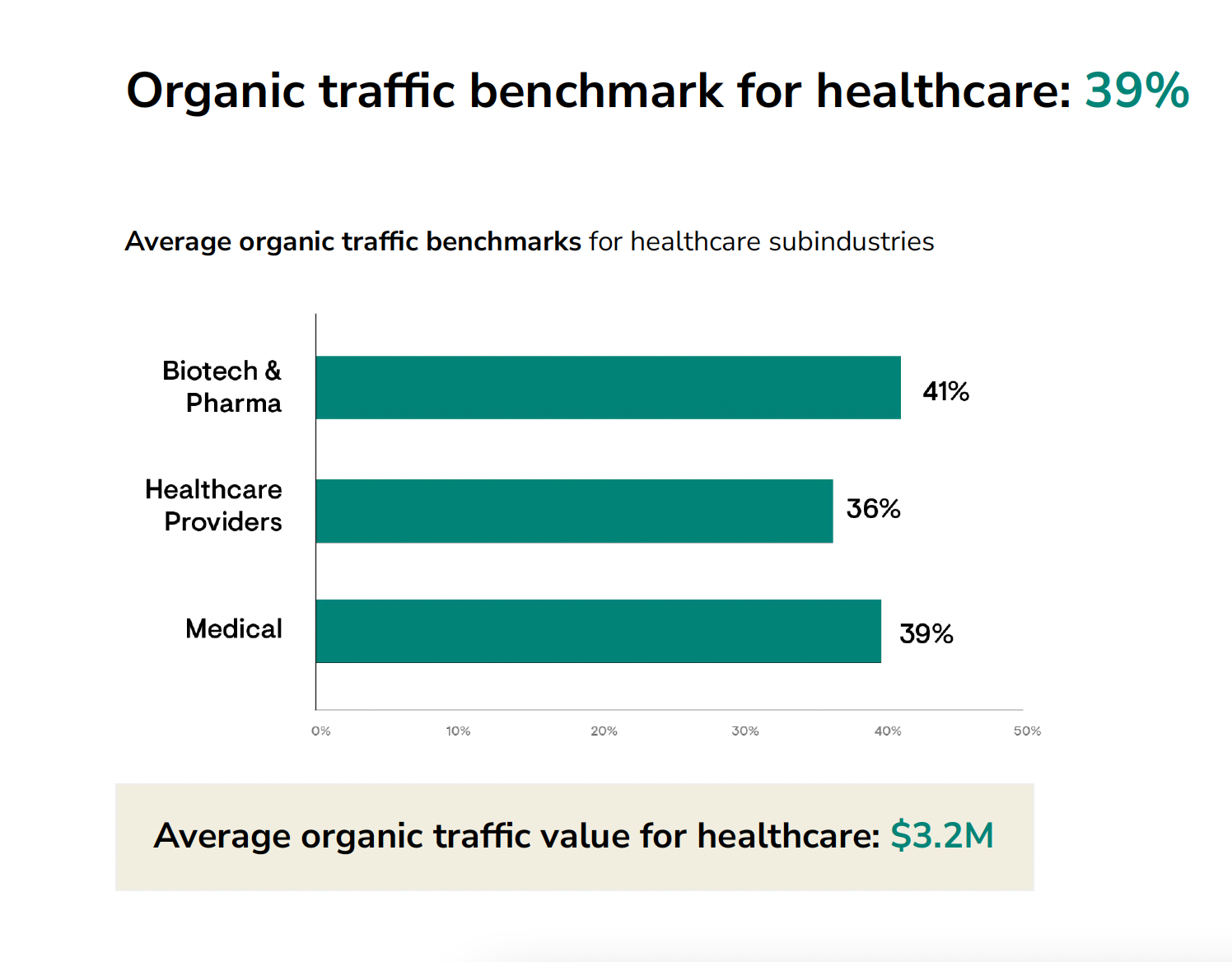 Image created by Conductor, July 2023
Image created by Conductor, July 2023
Branded Vs. Non-Branded Traffic KPIs For Healthcare
Healthcare’s top-performing businesses saw, on average, 43% of their organic traffic come from branded search terms, while 57% came from non-branded traffic.
Here’s the breakdown, buy subindustry:
Biotech & Pharma: 46% branded organic traffic, 54% non-branded organic traffic. Healthcare Providers: 66% branded organic traffic, 34% non-branded organic traffic. Medical: 18% branded organic traffic, 82% non-branded organic traffic.Top Healthcare Content Providers
To understand how your content compares to the Healthcare companies who rank at the top of SERPs, take a look at each top-ranking company in your subindustry.
The top content providers for the Biotech & Pharma subindustry:
MayoClinic WebMD NIH: National Cancer Institute CDC NIH: National Institute of Mental HealthThe top content providers for the Medical Providers subindustry:
MayoClinic Cleveland Clinic Medicine Plus Humana Value PenguinThe top content providers for the Medical Providers subindustry:
MayoClinic Cleveland Clinic NIH: National Institute of Mental Health CDC MNTTop SERP Rich Result Types For Healthcare
The top 3 rich search result types for Healthcare are:
People Also Ask: 95% Featured Snippet: 75% Image: 14%SEO Benchmarks For Retail
Investing in innovative content strategies and staying attuned to search trends can significantly optimize organic traffic and ROI for B2C retail businesses.
Key Takeaways
Retailers can capitalize on emerging trends, like Taylor Swift’s Eras Tour, to create era-specific apparel collections, boosting SERP rankings. Reduce paid spend and increase organic traffic by investing in innovative content strategies.Top SERP Performers In The Retail Industry
Top players like Healthline, MasterClass, H&M, Allrecipes, and RTINGS.com dominate their industry by following global trends, using direct language, and leveraging glossary-type FAQ content.
Organic Traffic Benchmarks For Retail
The top-performing businesses within the retail sector often see 32% of their traffic coming from organic search, on average.
Here’s a breakdown by subindustry:
Apparel: 28% Consumer Electronics: 35% Food & Grocery: 28% Health & Beauty: 36%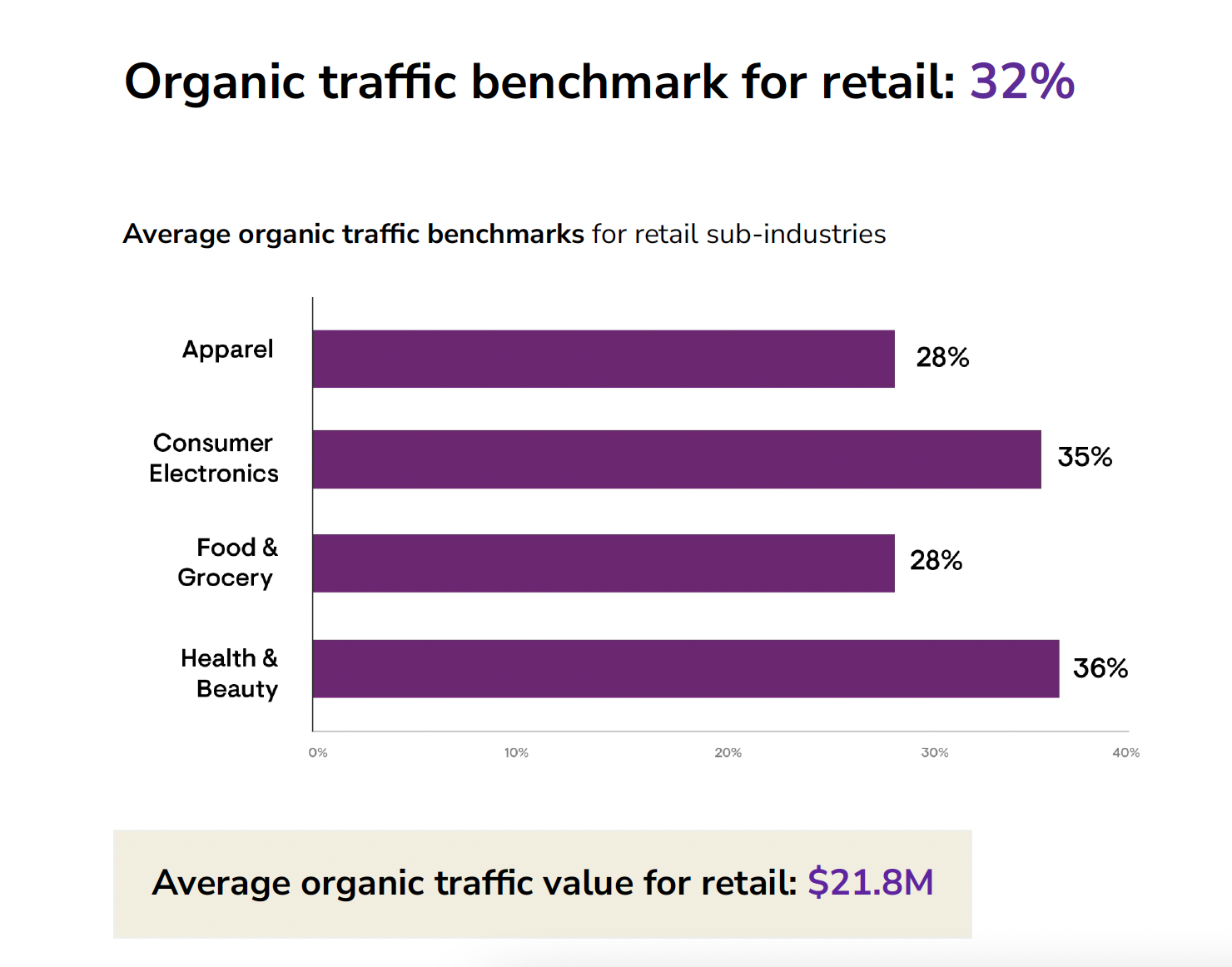 Image created by Conductor, July 2023
Image created by Conductor, July 2023
Branded Vs. Non-Branded Traffic KPIs For Retail
On average, retail’s top-performing businesses saw 70% of their organic traffic come from branded search terms, while 30% came from non-branded traffic.
Here’s the breakdown, buy subindustry:
Apparel: 68% branded organic traffic, 32% non-branded organic traffic. Consumer Electronics: 59% branded organic traffic, 41% non-branded organic traffic. Food & Grocery: 83% branded organic traffic, 17% non-branded organic traffic. Health & Beauty: 70% branded organic traffic, 30% non-branded organic traffic.Top Retail Content Providers
To understand how your content compares to the Retail companies who rank at the top of SERPs, take a look at each top-ranking company in your subindustry.
The top content providers for the Apparel subindustry:
Land’s End MasterClass H&M Fashion Beans NordstromThe top content providers for the Consumer Electronics subindustry:
RTINGS.com Consumer Reports CNET Make Use Of TechradarThe top content providers for the Food & Grocery subindustry:
Allrecipes Food Network Healthline Delish The SpruceThe top content providers for the Health & Beauty subindustry:
Healthline InStyle Byrdie WebMD Good HousekeepingTop SERP Rich Result Types For Retail
The top 3 rich search result types for Retail are:
People Also Ask: 89% Featured Snippet: 37% Image: 11%SEO Benchmarks For Technology
SEO performance varies among sub-industries like cybersecurity, hardware, and SAAS providers in the technology sector. Monitoring these KPIs can help optimize your SEO strategy for long-term ROI.
Key Takeaways
Cybersecurity and SaaS should rely more on brand recognition via direct, referral, and paid traffic. Get as granular as possible when identifying your organic KPIs. Use the subindustry-specific benchmarks here to evaluate whether you’re on par with other enterprise domains. Outperform your indirect competitors, like publishing sites, by using a targeted and strategic content strategy powered by in-depth keyword research for your target audience.Top SERP Performers In The Technology Industry
Top players like TechTarget, SalesForce, Digital Guardian, and Mircosoft dominate their industry through the vast amount of content they produce on varying topics.
Organic Traffic Benchmarks For Technology
The top-performing businesses within the tech industry often see 41% of their traffic coming from organic search, on average.
Here’s a breakdown by subindustry:
Cybersecurity: 36% Hardware: 53% SaaS: 33%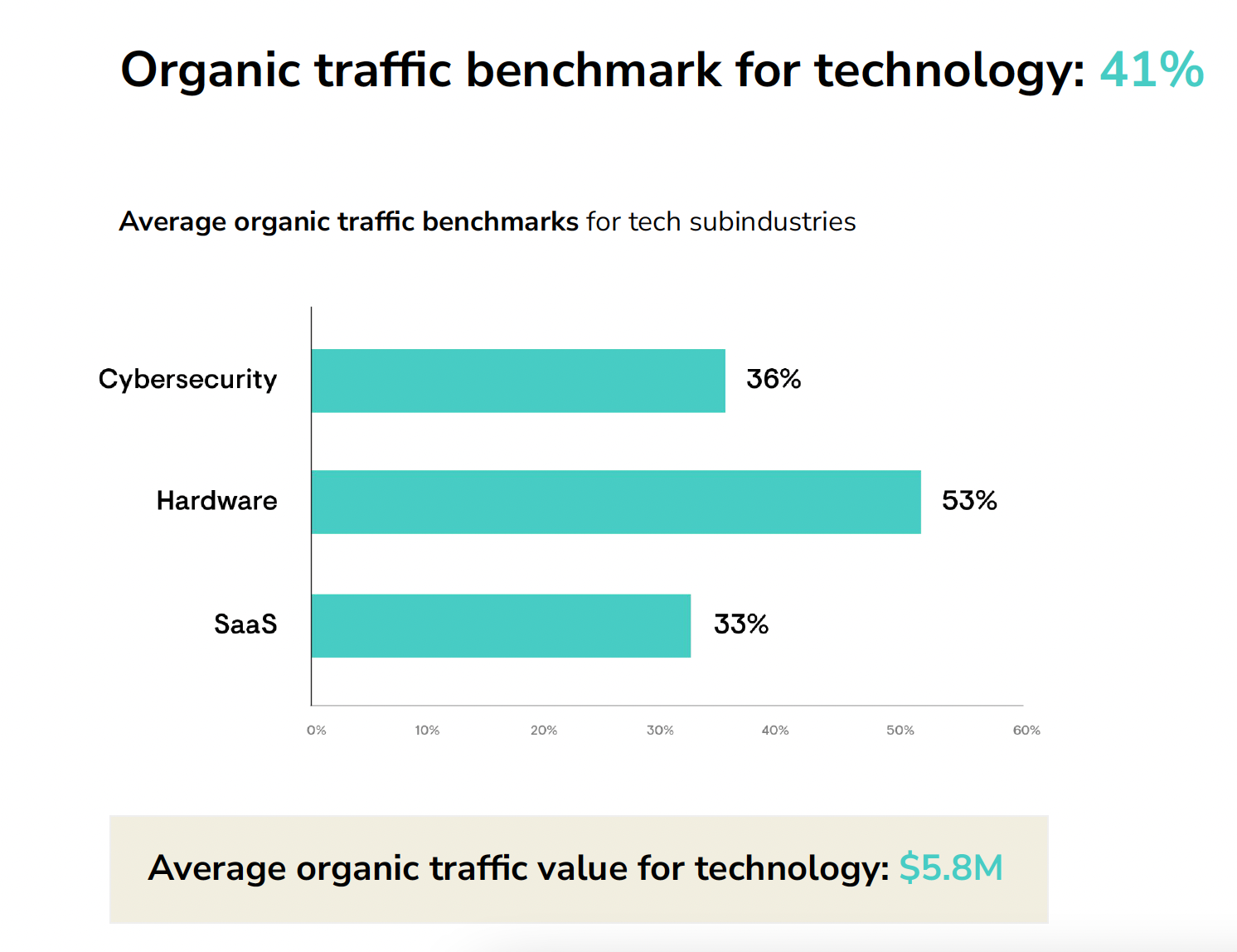 Image created by Conductor, July 2023
Image created by Conductor, July 2023
Branded Vs. Non-Branded Traffic KPIs For Tech
On average, Tech’s top-performing businesses saw that 51% of their organic traffic came from branded search terms, while 49% came from non-branded traffic.
Here’s the breakdown, buy subindustry:
Cybersecurity: 46% branded organic traffic, 54% non-branded organic traffic. Hardware: 51% branded organic traffic, 49% non-branded organic traffic. SaaS: 56% branded organic traffic, 44% non-branded organic traffic.Top Technology Content Providers
To understand how your content compares to the tech companies who rank at the top of SERPs, take a look at each top-ranking company in your subindustry.
The top content providers for the Cybersecurity subindustry:
TechTarget Digital Guardian Norton Tableau OktaThe top content providers for the Hardware subindustry:
TechTarget Check Point Analog Devices Square Paloalto NetworksThe top content providers for the SaaS subindustry:
Salesforce Microsoft TechTarget Oracle SAPTop SERP Rich Result Types For Technology
The top 3 rich search result types for Technology are:
People Also Ask: 97% Featured Snippet: 34% Image: 18%SEO Benchmarks For Travel & Hospitality
SEO performance varies among sub-industries like hotels and resorts and travel intermediary providers in the travel and hospitality sector. Monitoring these KPIs can help optimize your SEO strategy for long-term ROI.
Key Takeaways
Travel interest is now at an all-time high post-COVID as travelers want to make up for lost time. The best time for travel & hospitality brands to invest in and adopt a proactive SEO strategy is now. Implement a scalable content strategy to answer your audience’s top and trending searches.Top SERP Performers In The Travel & Hospitality Industry
Top players like Booking.com, Luggagepros.com, Travel Lemming, and Travel & Leisure dominate their industry by crafting high-quality, evergreen, and dictionary content that ranks for informational searches.
Organic Traffic Benchmarks For Travel & Hospitality
The top-performing businesses within the travel and hospitality sector often see 35% of their traffic coming from organic search, on average.
Here’s a breakdown by subindustry:
Hotels & Resorts: 38% Travel Intermediaries: 31%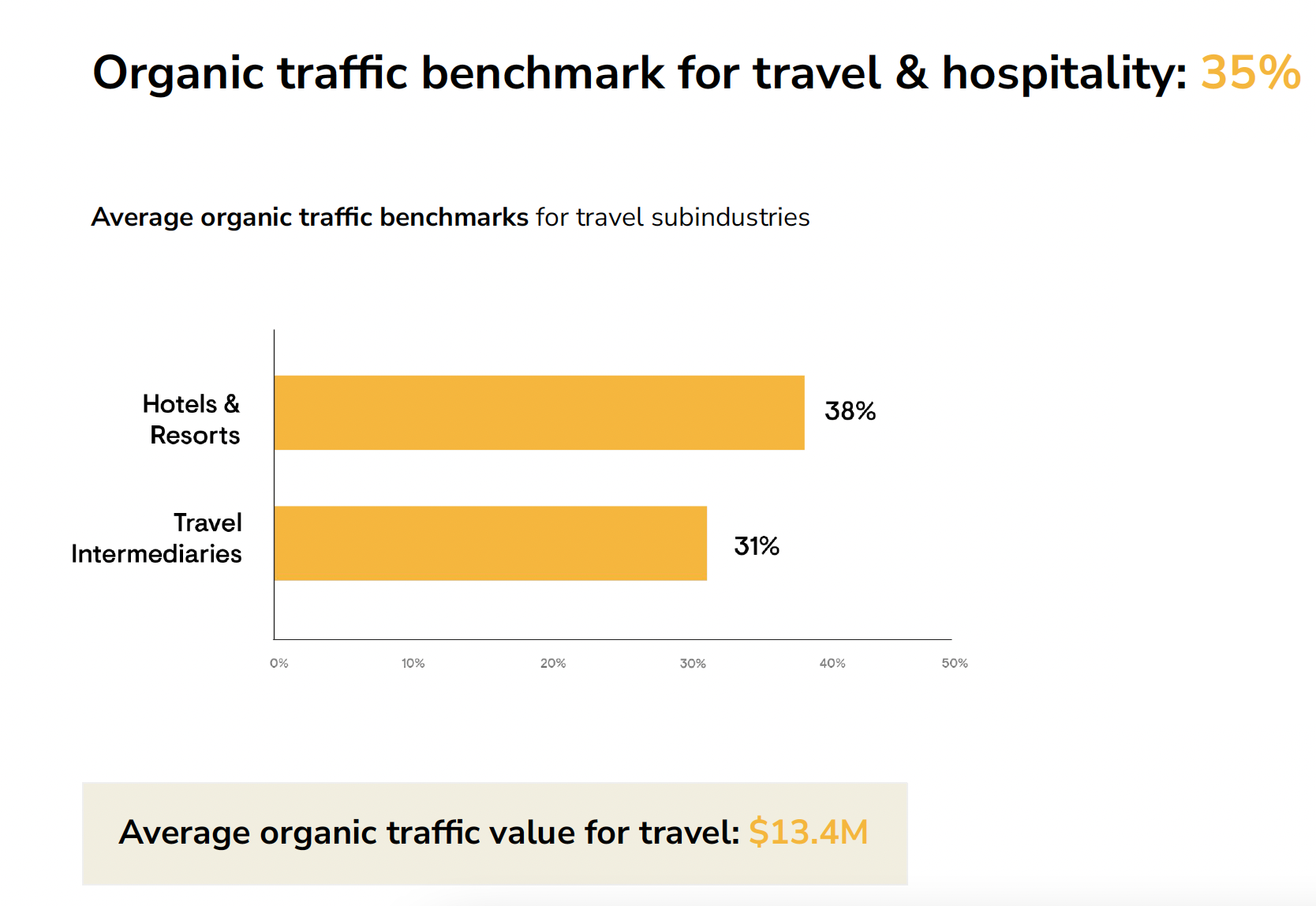 Image created by Conductor, July 2023
Image created by Conductor, July 2023
Branded Vs. Non-Branded Traffic KPIs For Travel & Hospitality
On average, travel and hospitality’s top-performing businesses saw that 52% of their organic traffic came from branded search terms, while 13% came from non-branded traffic.
Here’s the breakdown, buy subindustry:
Hotels & Resorts: 87% branded organic traffic, 13% non-branded organic traffic. Travel Intermediaries: 18% branded organic traffic, 82% non-branded organic traffic.Top Travel & Hospitality Content Providers
To understand how your content compares to the travel and hospitality companies that rank at the top of SERPs, take a look at each top-ranking company in your subindustry.
The top content providers for the Hotels & Resorts subindustry:
Booking.com Travel Lemming Tripadvisor Budget Your Trip Frommer’sThe top content providers for the Travel Intermediaries subindustry:
Luggagepros.com Travel & Leisure Travelpro Skytrax World Airline Awards OneTravelTop SERP Rich Result Types For Travel & Hospitality
The top 3 rich search result types for travel and hospitality are:
People Also Ask: 75% Featured Snippet: 74% Image: 5%SEO Benchmarks For Professional Services
In the professional services sector, SEO benchmarks are critical for gauging success.
Key Takeaways
Build trust with users who land on your content and implement strategies to convert them to potential customers down the line. Implement a keyword research-intensive content strategy to win undecided users over to your offering or service through authentic, value-driven content. Develop a value-based and comprehensive content strategy with dedicated long-form pieces to satisfy user intent.Top SERP Performaners In The Pro Services Industry
Top players like Indeed, Contracts Counsel, TechTarget, and Hubspot dominate their industry by crafting in-depth content that meets the user’s search intent and needs.
Organic Traffic Benchmarks For Professional Services
The top-performing businesses within the finance sector often see 39% of their traffic coming from organic search, on average.
Here’s a breakdown by subindustry:
Consulting: 36% Recruiting: 27% Corporate Law: 55%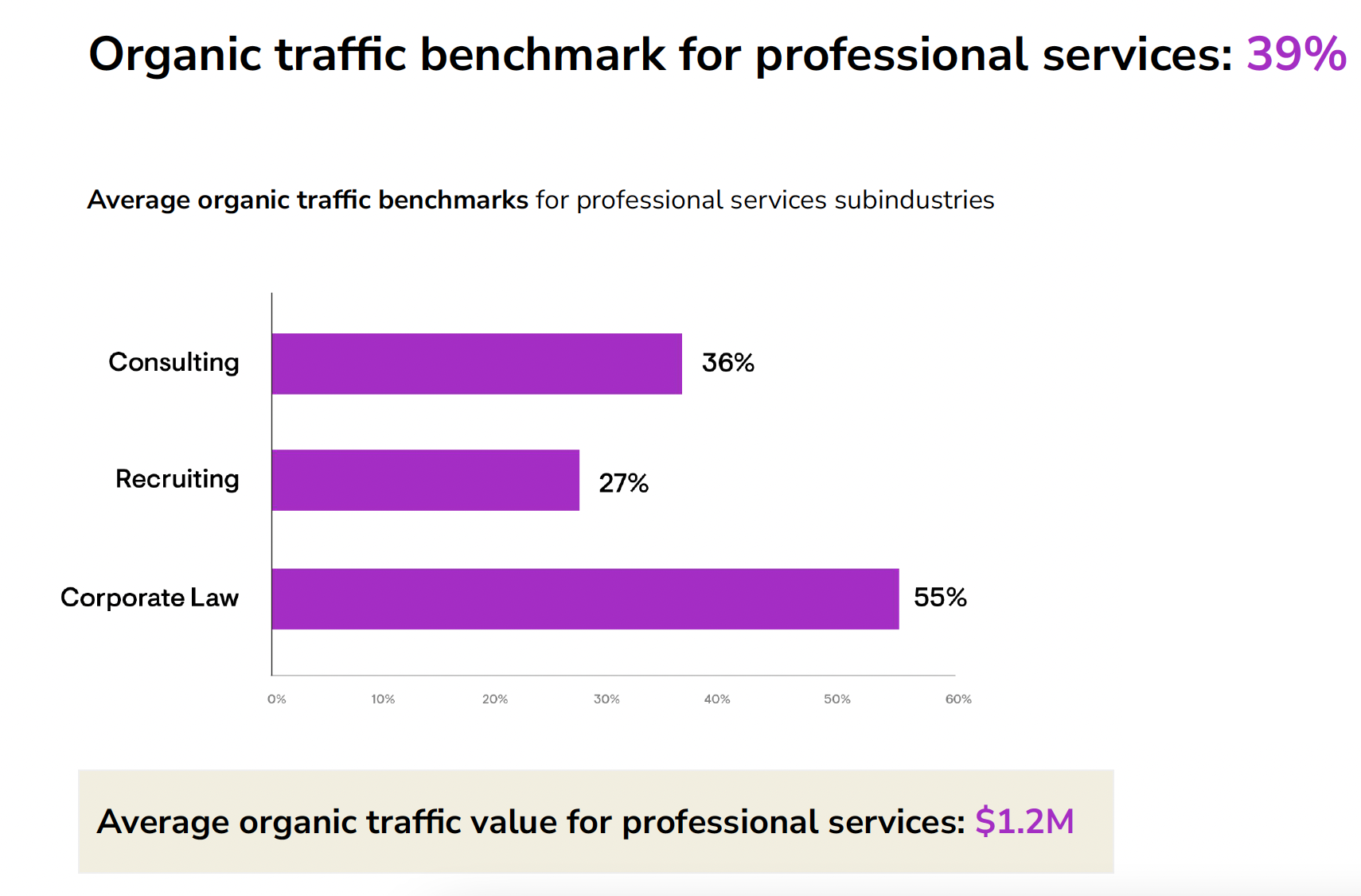 Image created by Conductor, July 2023
Image created by Conductor, July 2023
Branded Vs. Non-Branded Traffic KPIs For Pro Services
On average, professional Service’s top-performing businesses saw 43% of their organic traffic come from branded search terms, while 57% came from non-branded traffic.
Here’s the breakdown, buy subindustry:
Consulting: 60% branded organic traffic, 40% non-branded organic traffic. Recruiting: 28% branded organic traffic, 72% non-branded organic traffic. Corporate Law: 42% branded organic traffic, 58% non-branded organic traffic.Top Professional Services Content Providers
To understand how your content compares to the Professional Services companies that rank at the top of SERPs, take a look at each top-ranking company in your subindustry.
The top content providers for the Consulting subindustry:
Indeed TechTarget HubSpot Case Interview InvestopediaThe top content providers for the Recruiting subindustry:
Indeed TechTarget Smart Recruiters ZipRecruiter NetSuiteThe top content providers for the Corporate Law subindustry:
Contracts Counsel Wolters Kluwer FindLaw Up Counsel HG.org Legal ResourcesTop SERP Rich Result Types For Professional Services
The top 3 rich search result types for Finance are:
People Also Ask: 93% Featured Snippet: 62% Image: 21%To stay competitive in the rapidly evolving field of SEO, it’s crucial to set informed, data-driven KPIs and measure them against industry benchmarks. This approach allows you to assess the ROI of your strategies effectively and make necessary adjustments.
Take note of specific rich result types like ‘People Also Ask,’ which consistently secure first-page rankings on Google, and optimize your content accordingly.
Request a free SEO analysis from Conductor to get a glimpse of where you have the best opportunities to rank and start driving increased organic traffic to your site today.
Image Credits
Featured Image: Image by Conductor. Used with permission.
SEO Maintenance: A Checklist For Essential Year-Round Tasks
By breaking SEO down into daily, monthly, quarterly, and annual process-driven tactics, you can plan more effectively and improve ROI.
 Corey Morris
24K Reads
Corey Morris
24K Reads

SEO is a big discipline. Without structure and planning, a lot of time and dollars can be wasted or used inefficiently.
A lot of SEO activities are started and never completed.
Couple that with the fact that SEO is never “done,” and it can be hard to start, finish, and stay on track with prioritized strategic and tactical elements that have a chance to make a real impact.
By breaking SEO down into daily, monthly, quarterly, and annual milestones and process-driven tactics, you can build the right level of planning to keep it on track and efficient.
These activities should be tied to goals and a larger strategy, but offer a great framework for how to make sure SEO is well planned and structured on an annual basis.
Daily
Educate Yourself
Staying up to date on industry news is a critical aspect of SEO that must be built into any maintenance or ongoing management plan.
This ranges from the mission-critical alerts and updates the search engines announce themselves to keeping tabs on SEO best practices and breaking news from sources like Search Engine Journal.
Big shifts in the industry are hard to miss.
But smaller, more subtle changes can become magnified when you miss them or best practices become outdated.
Don’t fall behind or deploy outdated tactics!
Know Your Current Metrics
Monitoring your key SEO performance metrics in real-time, or at least once per day, is especially necessary for brands and companies that rely on ecommerce transactions or lead volume to feed a sales team.
Knowing how your website is performing in search through top-level metrics is important for recognizing any red flags. These could include:
A specific or aggregate positioning drop. An organic traffic drop. A decrease in sales or lead volume.Being able to recognize problems as soon as they happen is key.
You need to be able to diagnose issues and reverse any negative trends before they impact your overall marketing and business goals.
By keeping tabs on actual performance, you can compare to benchmarks and baselines to make sure that you fully understand cause and effect with your metrics and not have an issue happen for too long before you can intervene.
You can monitor less critical KPIs (any that don’t necessitate an immediate reaction) on a weekly basis.
Make Progress On Tactics
A solid SEO plan or campaign must have goals, a strategy, and specific tactics outlined.
Without a plan, process, or defined approach, you can waste a lot of time chasing specific SEO aspects that might be low impact and low priority.
The daily process should include specific tasks, milestones, and achievable actions that work toward the bigger picture.
The tactics can include things being done for the first time in a phased approach or action items that are more in a rinse and repeat methodology.
Regardless, the list of specific technical, on-page, and off-page action items should be defined for the year, broken out into months, and further into tactics and progress that can be made on a daily basis to stay on track.
SEO requires both big picture thinking and the ability to tackle daily tasks and action items.
Monthly
Report On Performance
Beyond the daily or weekly KPI monitoring, it’s often important to use monthly cycles to more broadly report on performance.
The focus of monthly checkpoints allows for dedicated time to compare a larger sample size of data and see trends.
Monthly performance reporting should include year-over-year comparisons of the completed month plus any available year-to-date stats.
Find meaningful intervals to measure and be consistent. Looking at bigger ranges of time helps to see trends that are hard to decipher in small sample sizes.
Any stories of the what and why for deviations in goal, celebrations for exceeding goals, and metrics that warrant possible changes to the plan are critical to the surface and prioritize through a dashboard or snapshot report of the performance data.
Recap Completed & Continuing Action Items
This is a chance to evaluate the tactics and execution in the previous month against the plan.
Was everything completed? Were there deviations? What obstacles or roadblocks were in the way or overcome?Looking at the past helps shape the future.
When you combine the action items and tactics with the performance data, you should get an overall picture of the reality of what is driving SEO performance.
Plan Next Month’s Action Items & Evaluate The Plan
Monthly intervals are great for ensuring accountability for the completion of tasks.
Even when the year is planned out, things change in SEO, and performance isn’t always what we expect after doing something the first time.
Taking a monthly planning approach, adjustments can be made to the plan like doubling down on a specific tactic or adjusting the overall strategy to recalibrate.
By being agile enough to monthly evaluate performance and tactics, you can avoid overthinking things and reacting too swiftly, but also not let too much time pass and lose footing with trends toward goals.
Having a good balance of planned tactics and actions versus the need for agile methods to pivot when needed is often the best approach to stay current and proactive.
Quarterly
Technical Issues Auditing
Assuming you have covered technical issues at the beginning of your SEO focus and are also watching for any that trigger red flags in daily and weekly monitoring, it is important to take a broader look through an audit each quarter.
This audit should include a review of reported issues in Google Search Console and Bing Webmaster Tools.
Plus, comparison to benchmarks and standards for site speed, mobile usability, validation of structured data, and the aspects that aren’t often looked at on a more frequent basis.
On-Page Issues Auditing
Without an audit process and even with frequent monitoring, things happen on websites.
A code update, database update, a plugin/extension update, or publishing content can cause duplicate tags, duplicate content, or even missing on-page elements.
A quarterly audit of on-page issues that can be conducted using a wide range of free and subscription third-party tools is important.
There are tools that will even send alerts and factor into the daily process if something changes like a meta description being wiped out.
Regardless, having a solid tools stack and process for quarterly evaluation and comparison to the previous audit is important to ensure that the results of the audit and any fixes needed are noted and make it into the tactical plan.
Link Profile Auditing
The SEO plan overall likely includes some form of link building.
Whether that is through attracting links with engaging content or a more focused plan of research and outreach, it is likely a part of the ongoing tactics (or should be considered, if it isn’t).
The investment of time and effort into the tactics makes it important to have visibility of the overall link profile and progress.
This might be a performance metric tracked in the monthly reporting phase, but quarterly should be audited in a deeper sense.
Evaluating the quality of links, the number of links, diversity of sources, relevancy of linked content, comparisons to competitors, comparisons to benchmarks, and period-over-period comparisons are all important aspects to ensure that the plan is performing as intended in the area of backlinks.
Plus, if not caught through daily or monthly efforts, any spammy links or negative SEO attempts can be caught here and addressed through the disavow process.
Local Listings Audit
Once local listings management is in maintenance mode, there won’t be a frequent need for major changes with NAP (name, address, phone) data or inconsistencies in listing data.
However, that doesn’t mean that it won’t happen and that it can be “set it and forget it.”
An audit using third-party tools to ensure accuracy and consistency of data is strongly advised at least quarterly.
This audit can identify issues that can be addressed on a one-off basis as well as provide guidance on performance and any needed changes to the content, reviews, and other aspects of the listings themselves beyond the basic NAP data.
If any third-party data sources or listings were missed, Google Business Profile data can be overwritten with inaccurate listing info.
Even if nothing changes with your management of listings, data can change and needs to be monitored at a minimum.
Yearly
Measure Performance
When running annual plans for SEO – and even when not on annual agreements or evaluation cycles – taking an entire year of data and evaluating it is helpful to advise strategy and find measurable ROI calculations.
SEO is a long-term process to achieve the most competitive positioning possible in search engines. It is a valuable investment of time to look at performance data over 12-month spans, compare it to previous periods, look at benchmarks, and celebrate successes.
Even if you don’t have annual budgets or agreements with outside partners/providers, taking an annual step back and looking at performance and the effort like an investment rather than an expense is important.
Planning Strategy & Tactics
In addition to reviewing yearly performance data, you should also be planning out your goals, strategy, and tactics for the next year.
Even though the plan could change a week into maintenance, having a plan, and setting a target is a key to measuring progress.
Without a plan and using past learnings and a realistic view of the resources being invested in the coming year, there can be a gap between expectations and reality.
It is best to sort this out before getting months down the road.
Conclusion
We all have goals and specific outcomes we want to achieve from our SEO investments and efforts.
Rather than reacting and getting pulled into things that scream the loudest, having a structure and organization to how the work is done can keep your time and investment focused.
Whether it is technical factors, on-page, content, or backlinks, by having a set cadence and structure in your approach you can balance both planned activities and maintain the agility needed to react at the moment.
And make sure that progress is made and priorities for SEO work don’t get out of balance.
More Resources:
10 On-Site Technical SEO Factors To Assess In An SEO Audit 110 Top SEO Tools That Are 100% Free How To Do An SEO Audit: The Ultimate ChecklistFeatured Image: Besjunior/Shuttertstock
6 SEO Concepts To Focus On Right Now
Search engines constantly change how they rank websites. Improve your SEO with these 6 up to date concepts.
 Roger Montti
21K Reads
Roger Montti
21K Reads

The search marketing industry has traditionally played catch-up to understanding new technologies deployed by Google and Bing.
Here are six developments in SEO related to how search engines rank that all search professionals must understand in order to work effectively.
1. Understand Content Blocks
A common mistake I see is people trying to write about a list of keyword phrases.
Traditional old-school SEO is to put the keyword phrase in the title element and then put variations of those keywords in the heading elements.
The modern search engine doesn’t understand pages in terms of keywords anymore. Search engines understand webpages in terms of topics, something that has been referred to as a topic taxonomy.
A taxonomy is the organization of topics into topic categories and subtopics of those topics.
Here’s an example of an old-school directory taxonomy that organizes topics like this:
Business > Ecommerce > Technology VendorsGoogle has published many research papers about topic taxonomies. A recent research paper about Topic Taxonomy Expansion starts out by referencing how topic taxonomy is useful in web search:
“Topic taxonomies that display hierarchical topic structures of a text corpus have substantially contributed to various knowledge rich applications, including web search and question answering.”
When a search engine looks at a title tag, it does so to understand what the topic of the webpage is.
Similarly, when a search engine looks at headings, it is trying to understand what the blocks of content, as indicated by the headings, are about.
A webpage is about a topic, and that webpage contains relevant subtopics.
Creating a webpage is made easier when you first list the main topic, followed by a list of the relevant subtopics.
Here’s an example:
Topic: How to Choose a Fishing Kayak Subtopics: Paddle kayak Pedal kayak Sit on top kayak Sit inside kayak Stable kayak for standing Roomy to fit gear Minimal because gear is not an issueOnce you’ve outlined the topic and relevant subtopics, you’re ready to write an on-topic article that’s easy for the search engines (and people) to understand.
2. Comprehensive Is Not Always On Topic
A common mistake I encounter in website audits of low-ranking pages is a tendency to overwrite.
There is nothing wrong with creating comprehensive content. But there’s a point at which the content veers off-topic.
How does this happen? How do you know it’s happening?
Writing the best webpage on a topic often requires being comprehensive.
That phrase, “How to Choose a Fishing Kayak,” encompasses multiple subtopics (as outlined above).
The topic of fishing kayaks contains many other topics.
Some of the broader fishing kayak topics are:
Kayak paddles. Trolling motors. Fish finders (sonar units). Short handle fishing nets. Gear crates.All of those subtopics are relevant to fishing kayaks. But they are not relevant to the topic of “How to Choose a Fishing Kayak.:
They are relevant for a different topic such as: “What Gear Does a Fishing Kayak Need?:
When writing content or auditing a client’s content, always keep an eye out for topic drift.
Topic drift is when the topic of the article starts to shift and veers into another topic.
Specificity means the quality of belonging to a particular topic.
Specificity became impossible to ignore since Google’s medical update (when Google weeded out sites that were off-topic) and has become increasingly important as Google adds more natural language understanding to the search engine.
3. Featured Image
Google’s new Search Generative Experience (SGE) summarizes a topic’s answer and shows listings from three websites at the top of the page, to the right of the AI-generated response.
The title and meta description are shown in the snippets, and also an image from the webpage’s featured image is scaled down to a thumbnail size.
That image is something you control, so make the best use of the featured image.
It may be useful to use a featured image that’s colorful and draws the eye’s attention.
Screenshot From Google’s Search Generative Experience
 Screenshot from Google SGE search results, June 2o23
Screenshot from Google SGE search results, June 2o23
Image #1 is colorful and centered.
Image #2 is off-center, obscuring the image’s subject when the featured image is cropped.
Image #3 is centered, but it’s dark and muted. Dark colors recede (which means stand back and diminish).
Do
Create a featured image that is colorful and centered. The main subject of the featured image must be in the center. Images with a colorful background draw the eye. It also works if the main subject is colorful.Don’t
Do not use an image where the main subject is to the right or left of the image. Google will display it, but it will look a little off. Don’t use an image in darkness or an overall color in a dark tone where the overall image is murky.4. Be Original
Many people complain about being indexed, but their content doesn’t rank. This is something that many are increasingly complaining about.
One of the reasons can be because there’s nothing different than what’s already out there.
Google’s John Mueller advised:
“You really need to make sure that what you’re providing is unique and compelling and high quality so that our systems and users in general will say, I want to go to this particular website because they offer me something that is unique on the web and I don’t just want to go to any random other website.”
I think part of the reason why this is happening is because the technology that’s supposed to help with ranking relies too heavily on search results and competitor analysis.
So what happens then is that a certain amount of homogeneity begins to creep in, where the same kinds of statements are being put out there, nothing that makes the site better in a useful way.
There are two legitimate reasons for competitor analysis:
Understanding the strengths and weaknesses of competitors. Understanding what the intent of the keyword phrases in the SERPs.Competitor analysis should never be about copying what competitors are doing.
Google can only rank what publishers put out there. If everyone publishes content with lists, that’s what Google will rank.
In many cases, the person who can figure out how to best serve the reader for a particular topic is the one that will shoot to the top of the search engine results pages (SERPs).
This is why I have never endorsed the practice of 10x writing, where you take what a competitor did and do the same thing but 10 times better.
Ironically, the original 10x strategy was rewritten and renamed as the Skyscraper strategy.
They are both the same thing – and neither, in my opinion, is a good strategy because it’s just repeating what others have already done.
Always start with the user and think about how best to answer their question. Does that mean adding a step-by-step? More illustrations?
As Google and Bing become better at natural language understanding, it becomes more imperative to better serve users in the way that the search query requires.
5. People Also Ask
There’s a trend where people are mining Google’s People Also Ask (PAA) feature to find subtopics to add to their content in order to be complete.
Some of those suggestions are subtopics of the main topic. But some of the suggestions are not.
So it’s super important not to take all the PAA suggestions and add them to your topic.
The reason not to use all of the PAA suggestions is that some are branching out to other topics, making them irrelevant to the main topic.
Logically, adding an irrelevant topic to an article does not make that article more relevant.
The whole purpose of the PAA feature is to help searchers find a different topic.
Google’s documentation says this about the PAA feature:
“Commonly called “People Also Ask”, these visual elements help users broaden their search journeys.
…Exploration features help searchers explore more questions or searches that are related to their original search query (also known as “People also ask”).”
The word broaden means to expand in distance or to widen something. Thus, some of the PAA suggestions are related but broader than the main topic.
Google’s page on PAA also notes:
“While you can’t control what shows up here, it can be helpful to pay attention to the related search queries when you’re thinking about topics you could write about for your site.”
Using PAA for content can be useful but can backfire if the article becomes too broad.
Don’t rely on PAA to understand what you should write about. Find out what people are interested in when they buy a particular product.
If you really want to dig deep, you can ask a salesperson what are the most common questions consumers ask about the product.
Check out what people are talking about on social media in relation to whatever topic you are writing about.
6. Fake It Until You Make It Doesn’t Work Anymore
Authentic Links
There are many shortcuts that some publishers take to create the impression of expertise or authority.
However, using AI to catch those shortcuts is becoming increasingly effective.
Google uses AI called SpamBrain to analyze linking patterns to catch fake links between websites. This AI can even learn to identify new tactics that link manipulators use.
An April 2023 Google article about SpamBrain noted:
“We also improved SpamBrain as a robust and versatile platform, launching multiple solutions to improve our coverage of different abuse types. One such example was link spam. As we shared in
December, we trained SpamBrain to detect sites building spammy links, as well as sites created to pass spammy links to other sites.
Thanks to SpamBrain’s learning capability, we detected 50 times more link spam sites compared to the previous link spam update.”
Inauthentic LinkedIn Profiles
Some publishers create fake authors with fake author bios in an attempt to manipulate what they believe is a Google algorithm related to Experience, Expertise, Authoritativeness, and Trustworthiness.
But LinkedIn is successfully identifying AI-generated images used to create those fake profiles, blocking and removing millions of fake profiles.
One affiliate marketer stated that LinkedIn caught 100% of their fake profiles used to support the fake author profiles used on their websites.
Read: How LinkedIn Catches Fake Profiles
Fake Google Business Reviews
Google is using machine learning models to catch fake user-contributed reviews before they are published.
Google uses a variety of signals to detect fake content (Read: How Google Catches Fake Business Reviews).
In 2022, it blocked or removed over 115 million fake reviews.
When I recently mentioned this to a local search professional, they told me that they advised their client against purchasing fake reviews, but they went ahead and did it anyway.
The local search professional told me:
“I literally just told a company not to. They went ahead anyway and did fake reviews. I think within 24-48 hours of the reviews being posted, their Google Business Profile was suspended.”
In addition to blocking and removing fake profiles and reviews, Google is also starting to sue businesses that create fake Google Business Profiles.
Google sued a scammer who created multiple fake Business Profiles in a monetization model called Rank and Rent.
What Google took exception to was the creation of fake business profiles, the creation of fake business websites, and the addition of fake reviews in an attempt to make those business profiles appear authentic.
Read: How Google Catches Fake Business Profiles and Reviews
Google and LinkedIn don’t catch all the fake business profiles, reviews, and links. But a LinkedIn engineer told me they catch 99% of them now.
Search Is Evolving In Every Direction
It is important not to stay locked into one way of search engine optimization. It’s wise to remain open to insights based on the latest authoritative information.
Equally important is to learn how to spot SEO misinformation, because there’s a lot of it out there.
For example, one trend I’m seeing is for an SEO pro to cite Bill Slawski as an inspiration and then go on to talk about things Bill never promoted or suggested.
Always check citations. Don’t assume that because someone says Bill Slawski said, or Google says, that what follows is correct. Always check citations.
But don’t let the prevalence of misinformation keep you locked into one way of doing things because search practices are evolving faster today than ever in my 20+ years of experience in this industry.
More resources:
How To Focus On What Matters In SEO As AI Accelerates Rapid Change 6 PPC Strategies To Focus On Now How To Build A Future-Proofed SEO Strategy When AI Is Changing SEOFeatured image by Dean Drobot/Shutterstock
How To Succeed In Google Discover
Google Discover is a mobile experience that helps users find info they didn’t know they needed. Here’s how to use it for your brand.
 Abby Hamilton
51K Reads
Abby Hamilton
51K Reads

As a search engine optimization specialist, you already know the importance of content that answers query intent. But what happens when an internet user doesn’t know what information they need?
Google took it upon itself to solve this with the release of Google Discover, first seen in 2018.
Known as Google Feed until 2018, Discover uses data the search engine has gathered about you to create a personalized content feed that proactively delivers relevant content.
Available exclusively on mobile devices, it goes beyond responding to queries by anticipating user behavior and delivering content it thinks you will find interesting and valuable.
Taking user activity into account to deliver results, it presents a new and powerful way to drive web traffic.
Google Discover can include a variety of different types of content, including news, articles, videos, advertisements, and special rich results like live sports scores. It appears on Google’s homepage and is highly personalized to each user.
As machine learning and artificial intelligence continue advancing, this new form of discovery looks likely to become more common – and accurate.
In this piece, we’ll take a deeper look at this technology and show you ways you can put it to work for you.
How Does Google Discover Work?
Google makes content eligible to appear in Discover once it has been indexed, and Google has determined it doesn’t violate its content policies.
Similar to the AI-driven video recommendations made by platforms like TikTok and Facebook, Google Discover uses an algorithm to create a custom feed.
Using information collected from user data, Discover has moved the search engine toward “query-less search,” in which the understanding of the individual user replaces the understanding of a singular query.
The user is the central focus with Discover.
Google Discover automatically shows personalized content based on a user’s:
Search history. Browser history. App activity. Location (dependent on your Google account setup and privacy settings).Google Discover uses your information to identify and display topics Google believes will be relevant for you, known as “interests.”
What’s Interesting?
To gain a deeper understanding of Google Discover interests, I looked at over 700 Google Discover interests (provided by members of the SEO community).
While this is an extraordinarily small sample size compared to all potential interests, there were a few notable observations.
Interests Related To Sports & Entertainment Were The Most Prevalent
While my Discover feed primarily focuses on who former Bachelor Peter Weber is dating, I imagine others’ feeds are full of the latest sports updates.
It’s Largely Focused On Hobbies & Activities
Whatever you do in your pastime – whether it be baking or beekeeping – you’re likely to see content on your favorite after-work activities.
Brands Also Had A Strong Presence
Almost every submission included specific brands or local businesses.
While Discover aims to suggest new content to users, it still remembers your go-to stores and restaurants.
SEO Has Its Own Category
We love SEO so much that it got its own category.
Thanks to all the SEO folks who filled out my Google Form.
Below is a visual of all submitted user interests, organized by category (i.e., finance, education, etc.) and type of entity (i.e., brand, product, person, etc.).
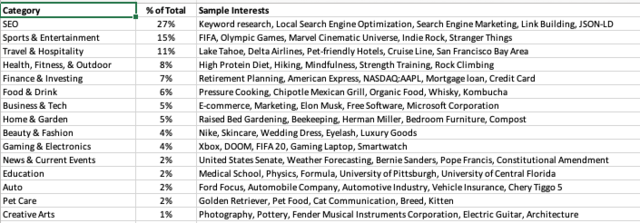 Screenshot from author, February 2023
Screenshot from author, February 2023
User Input
Users can also provide direct feedback to further customize their feed by following or unfollowing topics, selecting “show more” or “show less,” and choosing not to see content from certain publishers.
Occasionally, Google will directly prompt the user for feedback.
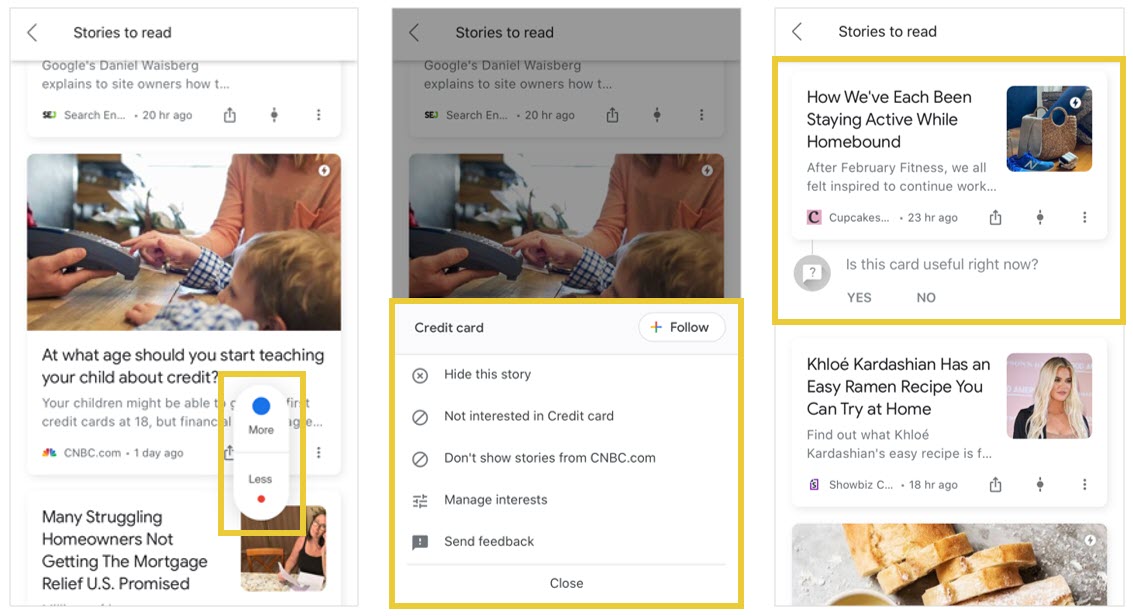 Screenshot from author, February 2023
Screenshot from author, February 2023
Is it Possible To Optimize For Google Discover?
Yes, it is possible to optimize for Google Discover. Google Discover is a personalized recommendation engine that aims to deliver relevant and engaging content to users based on their interests and browsing history.
To optimize for Google Discover, it’s important to focus on creating high-quality and engaging content that resonates with your target audience.
The key difference between traditional search engine optimization and optimizing for Google Discover is a shift in focus from the query to the user.
While traditional SEO aims to target specific queries and provide the most relevant results, Google Discover focuses on delivering content that match users’ interests without explicit search queries.
There are a number of steps publishers can take to increase their visibility in Discover.
Those include:
Creating high-quality, engaging content. Adding structured data to your articles. Publishing about trending topics. Use high quality images and videos. Optimize for page experience. Have strong E-E-A-T.Importance Of Expertise, Experience, Authority, And Trust (E-E-A-T)
Google Discover strives to recommend content that is not only interesting but also trustworthy, reliable, and credible.
The elements of E-E-A-T (Expertise, Experience, Authority, and Trustworthiness) play a pivotal role in determining the suitability of content for recommendations. You didn’t expect Google to recommend just any content, did you?
When creating content for Google Discover, it’s important to be selective and prioritize topics that align with your expertise or the expertise and experience of your content creators.
Focus on providing valuable and relevant information on those subjects to build authority in your niche over time, which yields better long-term results compared to broad topics that don’t closely align with your brand and expertise.
Once you’ve identified suitable topics, take the following steps to improve your E-E-A-T signals:
Produce High-Quality Content: Create well-researched, accurate, and informative content that brings value to your audience. Avoid publishing misleading, sensational, or low-quality content that can harm trust. Regularly Update Content: Clearly indicate the publication dates, update outdated articles, and annotate dates of updates when relevant. Showcase Expertise: Highlight the credentials, qualifications, and experience of your authors or content creators to demonstrate expertise. Include author bios, professional backgrounds, certifications, or industry recognition. Leverage Structured Data: Leverage Article and Author markup to provide clearly annotated information to search engines. Cultivate a Reputable Track Record: Consistently publish relevant, high-quality content to establish a track record of consistency and build authority in your niche. Ensure Transparency: Clearly attribute sources, cite credible references, and be transparent about editorial policies, fact-checking processes, quality assurance, and any affiliations or sponsorships. Improve Website Experience: Create trustworthy, user-friendly experiences by focusing on factors like mobile-friendliness, page load speed, HTTPS, and overall website design.By following these steps, you can enhance your E-E-A-T factors, provide valuable content, and create a trustworthy and credible presence that improves your chances of being recommended in Google Discover.
Isn’t Google Discover Just News?
Well, kind of.
One of the goals of Google Discover is to serve fresh content – and scrolling through the Discover feed, it is mostly news.
But when clients from other industries started seeing Discover traffic in Google Search Console (GSC), it was time to investigate.
I analyzed 12 months of Google Discover traffic to over 11,000 URLs from 62 domains. Of those 11,000 URLs:
46% were from news sites. 44% were from ecommerce sites. 7% were from entertainment sites. 2% were from travel sites.The remaining 1% were from other industries including:
B2B. Automotive. Education. Finance. Health.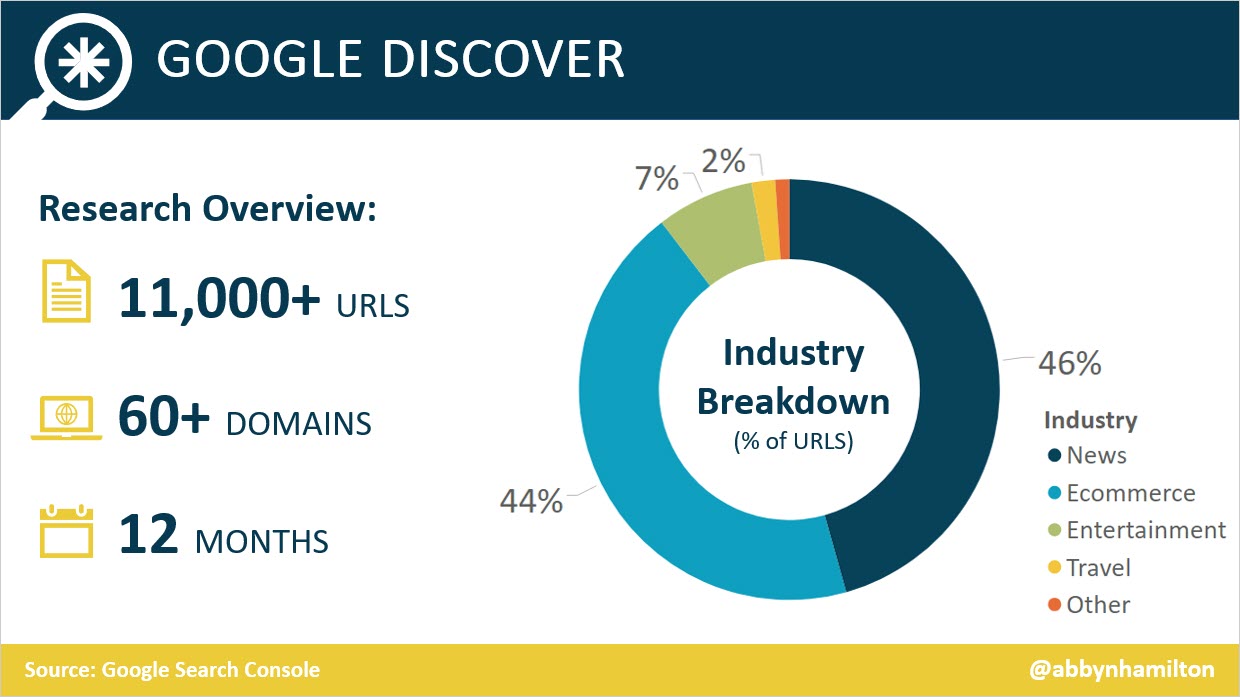 Screenshot from Google Search Console, April 2020
Screenshot from Google Search Console, April 2020
Research Findings
1. News Sites Received 99% Of Clicks
While news accounted for less than half (46%) of URLs analyzed, it received 99% of Discover clicks and got significantly more clicks per page.
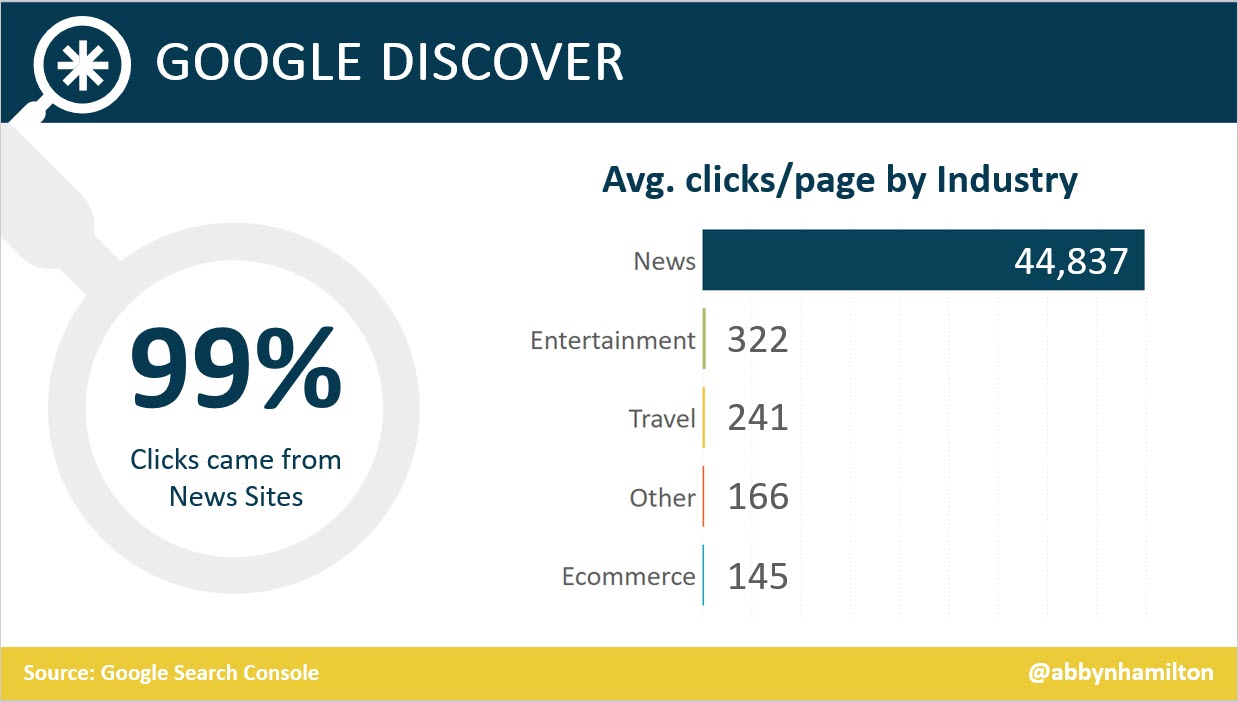 Screenshot from Google Search Console, April 2020
Screenshot from Google Search Console, April 2020
One news domain in the analysis saw over 30% of its total web traffic coming from Discover, while other publishers have reported that Google Discover drove more traffic than organic search in some months.
It’s likely that news content is shown to a large, broad audience, while content from other industries is targeted to smaller audiences based on specific interests.
Google emphasizes this idea in the announcement of Google Discover, stating:
“When it comes to news, we believe it’s important that everyone has access to the same information.”
Takeaway: Google Discover is a major traffic driver for news publishers and can be used to reach a large, broad audience.
2. Blog Posts Are Prevalent Across All Other Industries
For non-news sites, the remaining 1% of clicks (still totaling over 1 million in the past 12 months) were dispersed across different types of content.
The most prevalent type of content across industries was blog posts.
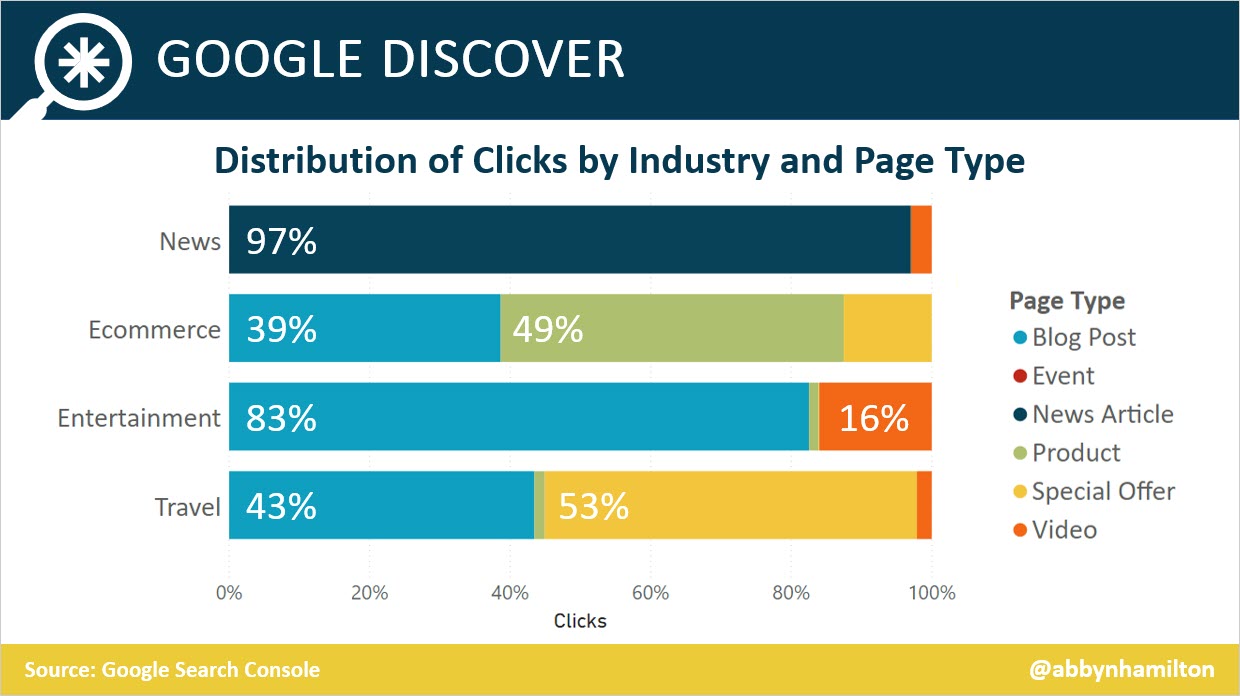 Screenshot from Google Search Console, April 2020
Screenshot from Google Search Console, April 2020
Blog topics that were displayed in Google Discover were highly relevant to specific interests/hobbies, such as hiking, makeup, and nutrition.
 Screenshot from Google Search Console, April 2020
Screenshot from Google Search Console, April 2020
Additionally:
49% of clicks to ecommerce sites went to product pages, which included both product category and product detail pages. Entertainment saw the largest percentage of clicks (16%) to pages with a video as the primary content (i.e., cast interviews, and movie trailers). Special offers, mostly travel or hotel deals with limited time/availability pricing, accounted for the largest percentage of clicks to travel sites (53%).Takeaway: Non-news content is heavily interest-focused and will likely be displayed to a smaller, more targeted audience.
3. Discover Content Typically Has A Short Shelf-life
Aligned with Google Discover’s focus on delivering fresh content, most of the URLs in this study only received traffic for three to four days, with most of that traffic occurring one to two days after publishing.
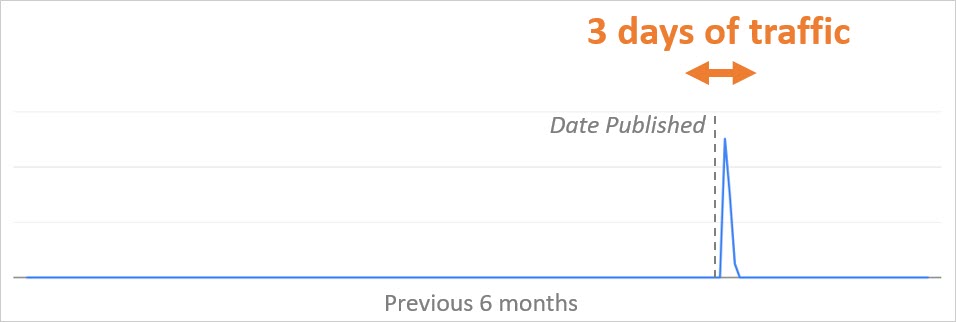 Screenshot from Google Search Console, April 2020
Screenshot from Google Search Console, April 2020
However, some more mature, evergreen content was able to drive longer-term traffic.
 Screenshot from Google Search Console, April 2020
Screenshot from Google Search Console, April 2020
This is the result of Google Discover serving evergreen content to meet new or evolving user interests.
In the instances where I’ve seen more mature, evergreen content appearing in my personal Discover feed, I was searching for similar topics two to three days prior.

Takeaway: Most pages in Discover have a short shelf-life, around three to four days, but evergreen content can drive longer-term traffic.
4. Users Respond Well To Discover Content
One of the first things that stuck out about Google Discover was a high click-through rate (CTR): 11% across all pages analyzed.
Excluding news sites (which accounted for most of the data), the average CTR was 6%.
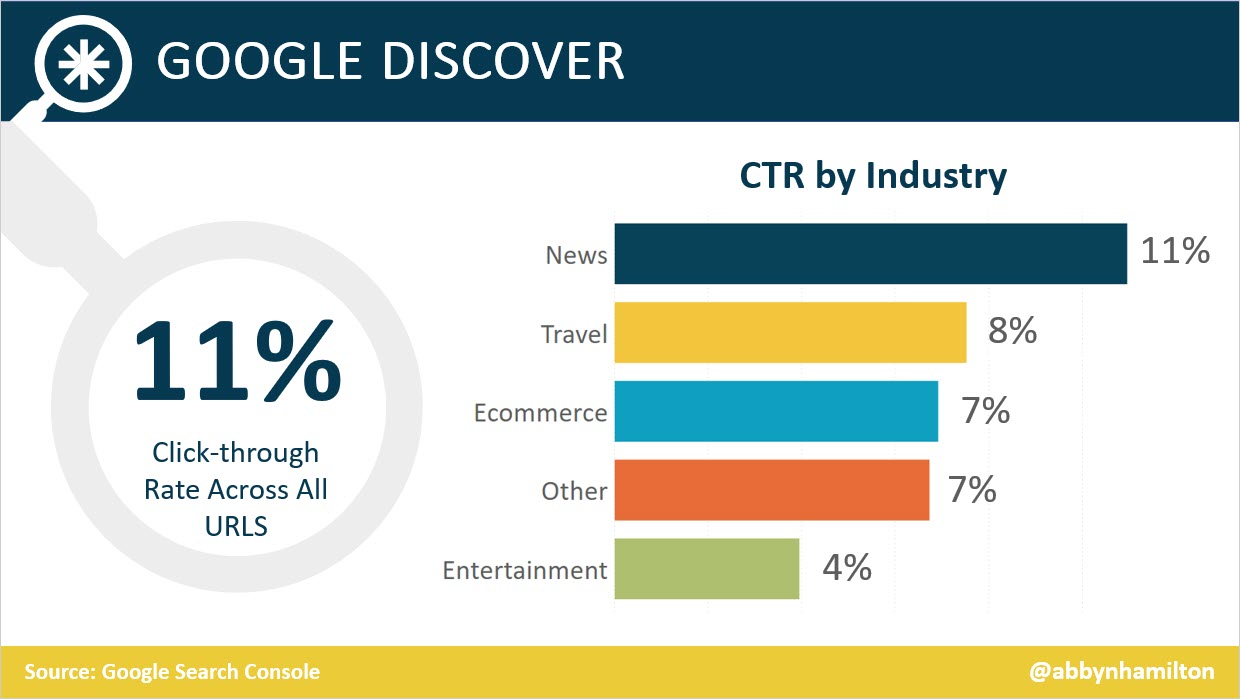 Screenshot from Google Search Console, April 2020
Screenshot from Google Search Console, April 2020
Looking at the same 62 domains, the CTR from traditional search was 4%.
Unfortunately, these numbers can’t be directly compared, as CTR is calculated as clicks ÷ impressions = CTR, and impressions are measured differently in Discover than in traditional search.
Here’s how:
Search impressions are recorded for a URL when a user opens a search results page containing the URL (even if the result is not scrolled into view). Discover impressions are recorded only when a Discover card is scrolled into view.Takeaway: Pages in Google Discover see higher CTRs than traditional search; however, this may be a result of the difference in how impressions are measured, rather than a difference in user behavior.
How To Connect With Users On Google Discover
In traditional search, queries serve as a connection point between a user’s need and relevant content (i.e., the user is hungry, searches [food near me], Google displays local restaurants).
Google Discover shows content before a user’s need is realized, “powered by the strength of the match between an article’s content and a user’s interests.”
Without keyword research and query reports, the traditional content creation process is limited – but there are still ways to increase the chances of appearing in Discover.
Be Mobile-Friendly
Google Discover is only accessible on mobile devices, so this one is obvious.
But it’s always good to cover your bases by checking Google Search Console’s Mobile Usability Report and making sure there are no errors. If you discover any, remedy them right away.
Focus Content Around Entities
Interests are entities, objects, or concepts that can be uniquely identified.
They can be anything from general hobbies, to niche interests, to specific brands and businesses.
Using the Entity Explorer by Marketer’s Center, you can view the relationships between entities and see what entities are associated with your brand, your industry, products, etc.
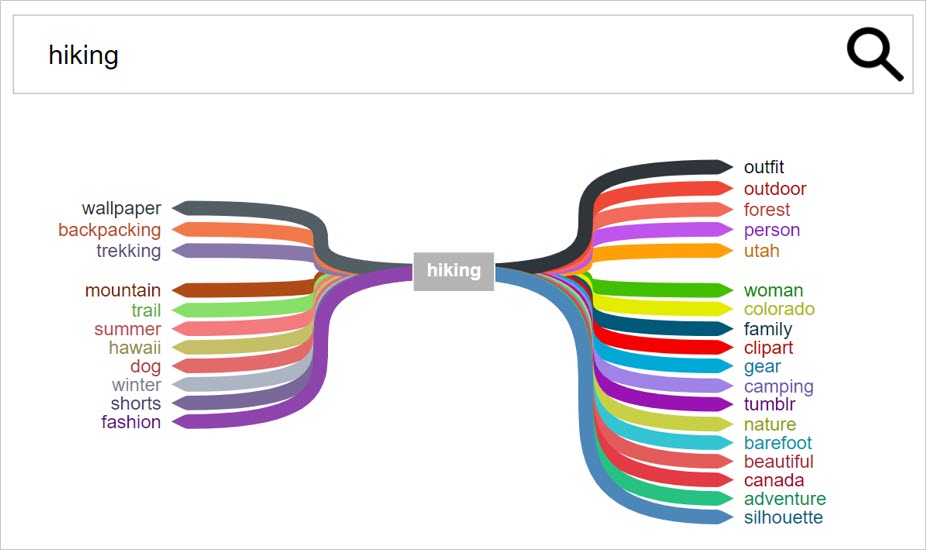 Screenshot from Entity Explorer, April 2020
Screenshot from Entity Explorer, April 2020
Identify what entities serve as a connection point between your brand and your users.
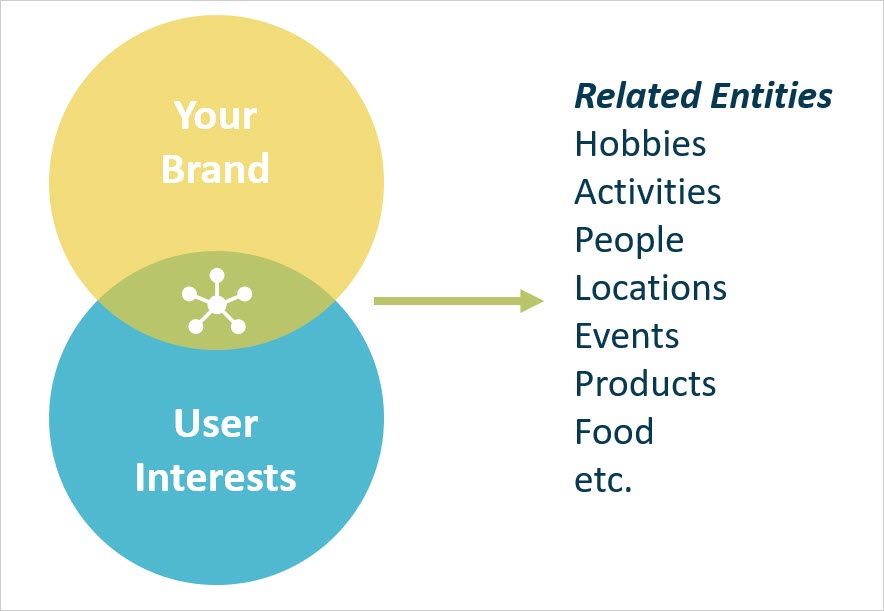 Screenshot from Entity Explorer, April 2020
Screenshot from Entity Explorer, April 2020
Hop On What’s Trending
Google Discover works in much the same way as a feed on a social networking platform.
To increase your chances of being featured, keep an eye on what’s happening on social media. Focus on trending events and topics.
Make sure you have optimized your social sharing buttons on your website.
Create Content That Is Relevant, Useful & Interesting To Your Audience
You are no longer bound by search volume.
Embrace this newfound freedom.
Once you’ve identified connection points – get specific and go in-depth.
Interest-based content is personalized, so write content that will resonate with your most passionate users.
One way to do this is to identify intersections and relationships between topics (i.e., “best ski resorts near Pennsylvania”, “running tips for winter”).
Bonus points if you can tie content into current events.
As mentioned above, make sure your topics also align with your expertise and your content and site demonstrate strong E-E-A-T.
Write Good Page Titles
To increase your chances of showing up in Discover, you should ensure all your page titles capture the essence of the content on that page – without being clickbaity.
This helps the algorithm quickly determine what your content is about and whether it is relevant to a particular user.
Include High-Quality Images
Aside from creating content your users will find interesting, the best way to boost content on Discover is to use large, high-quality images that are at least 1,200 pixels wide and enabled by the max-image-preview:large setting or by using AMP.
Avoid using your site logo as your image.
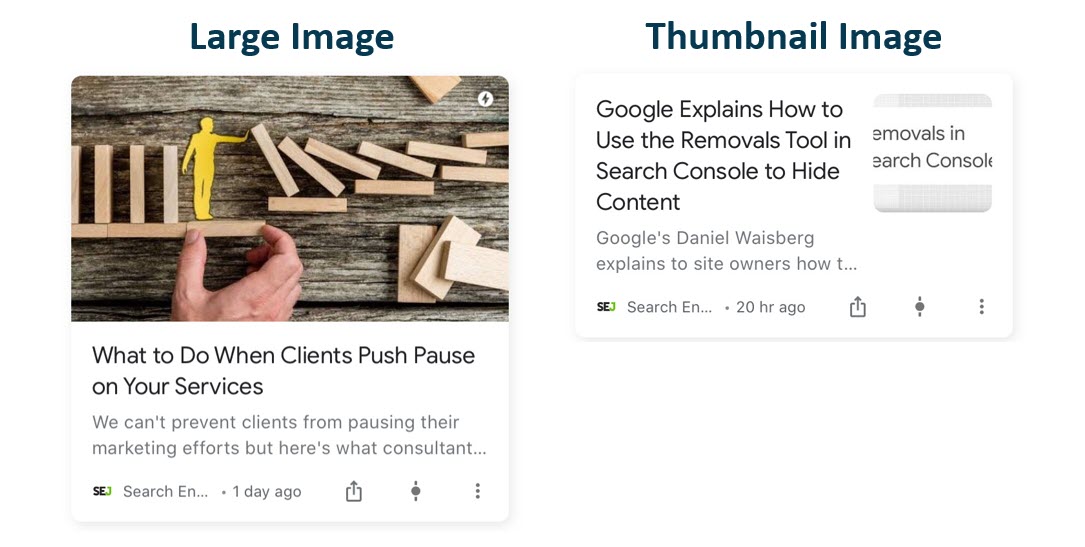 Screenshot from author, February 2023
Screenshot from author, February 2023
For more ways to optimize images in Discover, check out Brodie Clark’s case study, Google Discover: An Image Could Be Worth 1,000 Clicks.
Revisit Your Video Strategy
Videos have a huge presence in Google Discover, which aligns with Google’s shift in focus from text to more visual ways of finding information.
While videos made up only 17% of the content in this analysis, this doesn’t include data for YouTube, which hosts a majority of videos appearing in Google Discover.
It may be hard to measure, but creating engaging videos and optimizing your YouTube channel could help increase your brand’s presence in Google Discover – and in traditional search too, as 19% of desktop search results include video carousels and 92% of those videos come from YouTube.
Avoid Exaggeration And Shock Tactics
Google Discover seeks to provide relevant and trustworthy information to mobile users. One way it does this is by penalizing sites that use misleading information or exaggerated details in preview content.
Similarly, any tactics designed for “cheap clicks” like content intended to outrage, titillate, or offend should be avoided.
Take Advantage Of The Follow Feature
One of the great parts of Discover is the Follow feature, which allows users to get the latest update from websites they’re following.
Available in English to people using Chrome Android, this feature uses RSS or Atom feeds by default.
If you have more than one feed on your site, you can optimize your Follow feature by telling Google which feed to follow in the <head> section.
To ensure Google can find your feed, make sure it’s not blocked with your robots.txt file, that your feed is up-to-date, and that you’ve included title and link elements.
Track Your Performance
Once you have content on Google Discover, you can monitor how it’s working via the Performance Report for Discover.
Here you’ll provide information on impressions, clicks, and click-through rates for any of your content that has appeared on Discover in the last 16 months. Note that you need a minimum number of impressions for this data to show.
For more tips on optimizing your content for Discover, Lily Ray has provided a list of 10 effective strategies.
Key Takeaways
Google Discover provides incredible opportunities for forward-thinking webmasters and search engine optimizers – and it’s definitely one you should take advantage of.
The best part is it should fit neatly in with your existing strategies. You still want to create high-quality content aimed at your target audience.
You’ll want to ensure your content is indexed and your site is mobile-responsive. But these are all things you should have been doing anyway.
Just remember that, like all things SEO, optimizing for Google Discover is an ongoing process.
But if your content is good and you follow the best practices discussed here, Google’s bots will begin picking your content more often as an automatic suggestion to users.
And that means more visibility, more traffic, and hopefully more conversions.
More resources:
Google Discover: 10 Characteristics of Top-Performing Content [Study] How to Get Your Website Listed in Google News Your Guide to Google E-A-T & SEOFeatured Image: Krakenimages.com/Shutterstock

 Tfoso
Tfoso 







